Abstract
This paper reviews recent progress in fault detection, reliability analysis, and predictive maintenance methods for grid-connected solar photovoltaic (PV) systems. With the rising adoption of solar power globally, maintaining system reliability and performance is vital for a sustainable energy supply. Common faults discussed include panel degradation, electrical issues, inverter failures, and grid disturbances, all of which affect system efficiency and safety. While traditional diagnostics like thermal imaging and V-I curve analysis offer valuable insights, they mostly detect issues reactively. New approaches using Artificial Intelligence (AI), Machine Learning (ML), and Internet of Things (IoT) enable real-time monitoring and predictive diagnostics, significantly enhancing accuracy and reliability. This study represents the introduction of a consolidated decision framework and taxonomy that systematically integrates and evaluates the fault types, symptoms, signals, diagnostics, and field-readiness across both plant types and voltage levels. Moreover, this study provides quantitative benchmarks of performance metrics, energy losses, and diagnostic accuracies of 95% confidence intervals. Adopting these advanced techniques promotes proactive management, reducing operational risks and downtime, thus reinforcing the resilience and sustainability of solar power infrastructure.
1. Introduction
The rapid expansion of renewable energy has significantly transformed the global energy landscape, with solar photovoltaic (PV) systems playing a crucial role in this transition. Grid-connected solar PV systems have become an essential component of modern energy infrastructures due to their ability to generate clean, decentralized, and environmentally friendly power at various scales. While these systems offer minimal greenhouse gas emissions and lower operational costs, they still face challenges related to reliability and performance [1]. With increasing research and large-scale deployment, solar energy is now recognized as one of the most prominent renewable energy sources, and grid-tied PV systems form a fundamental part of contemporary power networks. Solar PV systems convert sunlight into electrical energy, which is then integrated into the electrical grid, reducing dependence on fossil fuels and contributing to lower carbon emissions. However, like any electrical system, grid-connected PV installations are susceptible to faults and operational inefficiencies that can compromise their effectiveness and longevity. Common issues include failures in electronic components such as solar panels and inverters, as well as external factors like grid disturbances and weather-induced damage. These failures can lead to significant energy losses and increased maintenance costs, making system reliability a critical concern. To enhance the dependability of these systems, predictive maintenance has emerged as a key solution, aiming to minimize operational downtimes through continuous monitoring of system parameters. By identifying deviations from normal operating conditions, predictive maintenance enables proactive interventions, thereby improving system efficiency and durability [2,3]. This review examines the existing research gaps related to grid-connected PV system faults, reliability, and predictive maintenance strategies, highlighting areas for further investigation and development. Figure 1 shows the growth of globally installed capacity across different regions over the past decade.
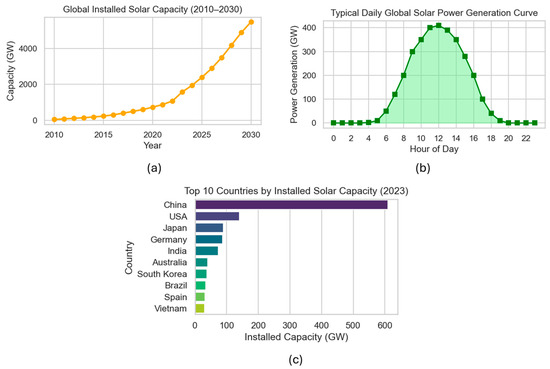
Figure 1.
Trends and global landscape of solar photovoltaic (PV) deployment. (a) Global cumulative installed solar PV capacity from 2010 to 2030. Historical data from 2010 to 2023 are based on IEA and IEA-PVPS reports, while projections from 2024 to 2030 reflect current deployment trends and global energy transition targets. (b) A typical daytime solar power generation profile under clear-sky conditions, highlighting peak generation around midday and zero output during nighttime. (c) Installed solar PV capacity of the top 10 countries as of 2023, showcasing China’s dominant position, followed by the USA, Japan, and Germany. Data emphasizes both the rapid growth and geographic distribution of solar power infrastructure globally.
The rising global energy demand has intensified the search for sustainable and environmentally friendly energy sources, with solar energy emerging as a leading candidate. Two decades ago, the production and deployment of solar energy systems posed significant challenges due to complex manufacturing processes and high costs. However, advancements in photovoltaic (PV) technology and improved grid integration have streamlined these processes, making solar power more accessible and efficient. Despite these advancements, solar energy systems, like any other power infrastructure, are prone to operational failures. Performance degradation over time—caused by panel aging, inverter malfunctions, and grid-related issues—can result in energy losses and increased maintenance costs [4,5]. To optimize the performance and longevity of grid-connected PV systems, reliability-centered designs have become essential. Various factors contribute to system malfunctions, including environmental conditions, manufacturing defects, and improper installation practices. Common issues such as shading, inadequate cleaning, poor electrical connections, inverter failures, and grid disturbances can significantly reduce system efficiency or, in severe cases, cause complete shutdowns. Understanding these failure mechanisms and their impact on PV system performance is crucial for researchers, engineers, and industry professionals to develop more robust, efficient, and resilient solar energy solutions [6,7]. Figure 2 shows the globally installed capacity of solar power at different locations of the world, with the largest individual solar farms, in which shady colors indicate greater installed capacity and larger farms; countries have solar generation <0.1 GW.
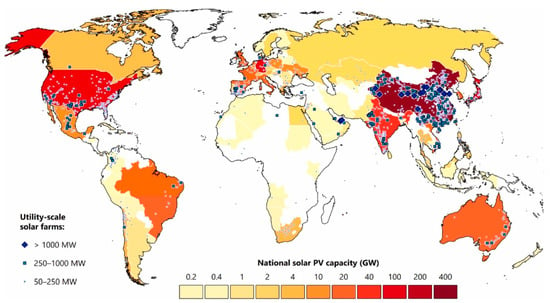
Figure 2.
Global installed solar power capacity, with the locations of the world’s largest individual solar farms. Darker colors indicate greater installed capacity and larger farms; countries shown in white have <0.1 GW installed capacity [8].
Ensuring reliability in grid-connected solar PV systems is essential for maintaining uninterrupted energy production and grid stability. Various stakeholders, including investors, system operators, and policymakers, emphasize the importance of system availability and operational efficiency. Unlike stand-alone solar PV systems, which operate independently without strict regulatory constraints, grid-connected configurations must comply with established power network regulations to ensure seamless integration and functionality [9]. Any failure within a grid-tied PV system can lead to power quality issues, voltage fluctuations, and, in extreme cases, grid instability. The reliability of a grid-connected solar system is influenced by multiple factors, including component quality, system design, environmental conditions, and maintenance practices. Research indicates that inverter failures contribute significantly to system downtime, underscoring the critical need for effective monitoring and maintenance strategies [10,11]. Additionally, the gradual decline in energy output due to potential-induced degradation (PID), hot spots, and delamination further highlights the complexities of ensuring long-term system reliability.
Solar power generation presents unique operational challenges compared to conventional energy sources, as its output depends on variable sunlight conditions. The intermittent nature of solar energy necessitates optimal performance of all system components to sustain stable power production. Frequent faults and failures can lead to substantial downtimes, escalating operational costs, and negatively impact the return on investment (ROI). In large-scale solar farms, even minor reductions in efficiency can result in significant financial losses. Therefore, enhancing system reliability is imperative for maximizing economic and energy benefits [12]. To improve reliability and ROI, solar system operators must adopt advanced monitoring and maintenance strategies. Traditional maintenance approaches fall into two primary categories: reactive maintenance, which addresses issues only after failures occur, and preventive maintenance, which follows scheduled inspections. However, both methods have limitations—reactive maintenance leads to unexpected downtimes, while preventive maintenance incurs high costs with no guarantee of preventing failures.
To overcome these shortcomings, predictive maintenance has emerged as a superior approach. By leveraging real-time data, artificial intelligence (AI), Internet of Things (IoT)-based monitoring, and advanced analytics, predictive maintenance enables the early detection of potential failures, minimizing downtime and optimizing system performance [13]. Despite being one of the most important components of renewable energy generation, the long-term reliability of Photovoltaic (PV) systems remains an enduring problem. Global installation capacity expansions are accompanied by considerable energy and maintenance cost losses due to inverter failures, module degradation, and grid instability. To minimize ongoing maintenance costs and maximize energy generation, understanding and mitigating the reliability issues, along with developing efficient fault detection and predictive maintenance systems, are of utmost importance [14].
1.1. Common Faults and Failures in Grid-Connected Solar Systems
Faults in grid-connected solar PV systems arise from electrical, mechanical, and environmental factors, each contributing to system underperformance and potential failures. Some of the most common failure mechanisms include the following:
- Module Degradation: Issues such as micro-cracks, delamination, encapsulate discoloration, and hot spots degrade PV modules over time, reducing power output and potentially leading to permanent damage.
- Inverter Failures: Inverters play a critical role in converting DC power from PV panels into grid-compatible AC power. However, their performance deteriorates due to thermal stress, aging, and software malfunctions, sometimes leading to complete system shutdowns [15].
- Grid-Related Issues: Voltage fluctuations, frequency variations, and regulatory constraints impact the operation of grid-tied PV systems, potentially causing grid instability if not managed properly.
- Electrical Connectivity Issues: Loose or corroded terminals, poor insulation, and inadequate grounding can result in power losses, fire hazards, and safety risks.
- Environmental and External Factors: Extreme temperature variations, humidity, dust accumulation, shading, and severe weather conditions (e.g., hailstorms and lightning strikes) accelerate degradation and increase failure risks. Hybrid systems incorporating battery storage also face challenges such as battery aging, capacity loss, and thermal runaway, which must be addressed to ensure system stability and longevity [16].
Since grid-connected PV systems consist of multiple interconnected subsystems, a failure in any single component can disrupt the entire operation. As a result, predictive maintenance at the subsystem level is crucial for ensuring continuous power generation and avoiding unexpected system failures. Since the overall system consists of multiple interconnected subsystems, a fault in any one of them can disrupt the entire operation. Therefore, implementing predictive maintenance at the subsystem level is crucial to ensuring system reliability and preventing unexpected failures. Figure 3 represents the general block diagram of a three-phase integrated grid-connected PV system (IGCPS) multilevel inverter for a solar photovoltaic (PV) system.
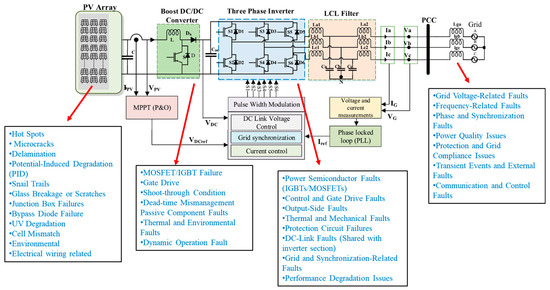
Figure 3.
Three-phase integrated grid-connected PV systems (IGCPS).
1.2. Role of Predictive Maintenance in Enhancing Reliability
Predictive maintenance is a proactive approach designed to minimize system underperformance and unexpected failures. Unlike reactive maintenance, which only addresses faults after they occur, and preventive maintenance, which schedules routine checks based on projected lifespan, predictive maintenance leverages advanced technologies to detect and prevent potential failures before they escalate [17]. Enhancement of modern power grids with the use of cutting-edge electronics, with creative approaches for the integration of solar energy, is achieved through the use of smart technologies, hybrid storage systems, and international cooperation [18]. Improvements in efficiency, stability, and sustainability are also addressed. Some of the most effective predictive maintenance methodologies include the following:
- Real-Time Monitoring and Data Analytics: Supervisory Control and Data Acquisition (SCADA) systems and IoT-enabled sensors continuously collect operational data. Advanced analytics tools identify deviations from normal performance, allowing for early fault detection [19].
- AI and Machine Learning-Based Fault Detection: AI-driven models analyze historical and real-time data to predict potential failures, estimate remaining useful life, and suggest corrective actions [20].
- Thermal Imaging and Infrared Inspection: Thermal cameras detect temperature anomalies and hotspots in solar panels, which indicate issues such as cell degradation and bypass diode failures [21].
- Drone-Based Aerial Inspections: High-resolution imaging and thermal scans from drones enable rapid fault detection at the module level, reducing inspection time and labor costs [22].
- Power Quality and Grid Stability Assessments: Advanced power monitoring systems ensure compliance with grid regulations, while also detecting anomalies that could lead to system faults or efficiency losses [23].
Despite these advancements, fully automated and efficient fault detection systems for grid-connected PV systems are still under development. Challenges such as integration of diverse data sources, lack of standardized diagnostic protocols, high implementation costs, and cybersecurity concerns must be addressed to ensure secure and effective predictive maintenance [24]. To further enhance predictive maintenance, emerging technologies such as Blockchain for secure data management and digital twins for real-time system modeling hold significant potential. Future research should focus on improving AI-based fault detection accuracy, enhancing sensor technology, and developing cost-effective maintenance strategies [25]. Given the increasing global reliance on solar energy, reliable grid-connected PV systems are essential for maximizing energy efficiency, minimizing operational costs, and maintaining grid stability. As predictive maintenance continues to evolve, it will play a pivotal role in ensuring prolonged system reliability, optimizing energy output, and reducing maintenance costs [26,27]. Figure 4 represents the basic factors defining the reliability and availability of the system.
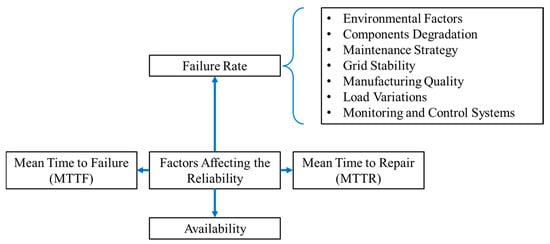
Figure 4.
Different factors affecting system reliability and Availability.
1.3. Reliability and Availability Analysis
Reliability assessment is essential for ensuring stable, safe, and efficient operation of solar photovoltaic (PV) systems, as it helps identify potential issues that can lead to reduced performance, energy losses, or unexpected failures. Accurate reliability evaluation enables proactive management, minimizes downtime, optimizes maintenance strategies, and significantly enhances system lifespan and sustainability [28]. As shown in Figure 5, reliability methodologies are broadly categorized into analytical methods (e.g., Fault Tree Analysis, Markov Models), simulation approaches (e.g., Monte Carlo simulations), data-driven techniques (e.g., Machine Learning and statistical methods), and component-based reliability analyses that include studying degradation impacts and maintenance strategies. Selecting appropriate methods from these categories is crucial to comprehensively assess and improve PV system reliability [29].
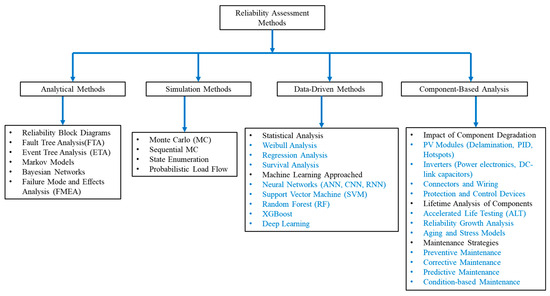
Figure 5.
Reliability assessment methodologies of a grid-connected photovoltaic system.
Contrary to previous reviews that concentrate on PV fault categories or single diagnostic methods, this review proposes a complete taxonomy that connects fault types → observable symptoms → signals → diagnostic methods → metrics of the diagnostic methods → field-readiness levels. This hierarchical arrangement captures the relationship between diagnostic methods and specific fault behaviors. Additionally, a criterion is proposed to assist PV plant operators in the choice of monitoring and maintenance methods based on system type, which may be residential, commercial, or utility, and voltage levels (LV, MV, and HV) [30]. These contributions provide coherent guidance that links the theoretical and practical aspects of PV fault detection and predictive maintenance. Our unified taxonomy and decision framework, illustrated in Figure 6, goes beyond simply aligning fault types, symptoms, signals, diagnostic techniques, and field-readiness levels. It also contextualizes each case and recommends prescriptive actions. Take, for instance, the case of a utility-scale medium-voltage (MV) plant where symptoms of potential-induced degradation (PID) are recurring. The framework identifies, designs, and prioritizes monitoring techniques that can help implement the recommended adjustments to reduce energy loss and improve reliability [31,32].
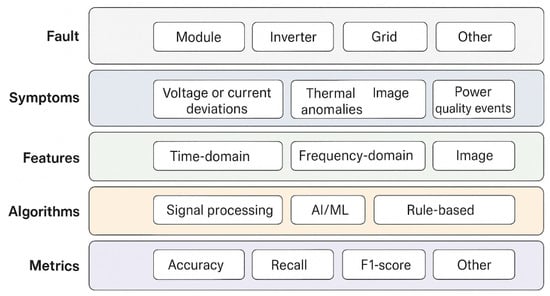
Figure 6.
Unified taxonomy and decision framework for PV fault detection and predictive maintenance.
2. PV System Network Configurations
Photovoltaic systems may be classified by their interaction with the electrical grid and associated components as shown in Table 1. The primary types are standalone systems, grid-connected systems, and hybrid systems, which encompass different frameworks, governance techniques, and modes of fault tolerance. Stand-alone systems do not require interaction with other grid systems and utilize charge controllers and batteries. Storage batteries, controller failure, and wiring corrosion constitute the primary degradation faults of such systems [33,34,35]. In modern installations, grid-connected systems gain popularity because they utilize power inverters and synchronization mechanisms, which facilitate the direct integration of power to the grid. These systems are mostly susceptible to faults within the inverter, the maximum power point tracker (MPPT), and grid-related components. Hybrid systems are capable of performing all functions simultaneously. They integrate battery banks or diesel generators to provide reliability during unstable grid periods. Inverters and control-logic conflicts constitute the primary ‘coordinated fault’ in such systems [36,37,38]. Every system configuration assists in fault classification and the development of precise predictive-maintenance techniques, because the topology and system connection determine fault origin and detection signals.

Table 1.
Classification of PV System Network Types and Common Faults.
3. Power Quality Impacts of Grid-Connected Solar Systems
3.1. Impact of Solar PV Systems on the Grid
The integration of grid-connected solar PV systems introduces several power quality challenges, including voltage fluctuations, frequency instability, harmonic distortions, and reactive power management issues. These factors can affect grid stability, reliability, and the overall efficiency of power distribution networks [39]. One of the primary concerns is voltage fluctuations, which arise due to the intermittent nature of solar power generation [40]. Since solar PV output varies based on solar irradiance, cloud cover, and weather conditions, the grid experiences sudden voltage surges and drops. These fluctuations are especially problematic in weak distribution networks with a high penetration of solar PV, leading to voltage instability and power quality deterioration [41]. Another significant issue is harmonic distortion, which occurs due to the conversion of DC electricity to AC using inverters. Poorly designed inverters inject harmonic currents into the grid, which can interfere with sensitive electronic devices, reduce transformer efficiency, and increase transmission line losses. Higher-order harmonics can also cause overheating in electrical equipment, further degrading power system performance [42]. Additionally, frequency instability becomes a growing concern with increased solar PV penetration. Unlike conventional power plants, which have large rotating generators providing inertia for frequency regulation, solar PV systems lack inherent inertia. This leads to rapid frequency deviations, requiring additional frequency regulation mechanisms such as battery energy storage systems (BESSs), and synthetic inertia from advanced inverters, or fast-response backup generation [43]. Another crucial factor is reactive power management, which is essential for maintaining voltage stability and power factor correction [44]. Many traditional solar inverters are designed to operate at a unity power factor, meaning they do not inject or absorb reactive power. Without proper reactive power compensation, voltage fluctuations and power losses increase, impacting overall grid efficiency. Advanced power electronics, dynamic reactive power compensators, and grid-supportive smart inverters are now being implemented to enhance power factor control and improve grid stability [45,46].
To mitigate these challenges, modern grid codes and regulations are being enforced to ensure that solar PV systems comply with power quality standards. The deployment of smart inverters, adaptive control mechanisms, and real-time grid monitoring technologies plays a critical role in stabilizing voltage and frequency levels [47]. Additionally, energy storage solutions help in balancing supply-demand mismatches by storing excess solar energy and releasing it during periods of low generation. By implementing these technological advancements and regulatory measures, grid-connected solar PV systems can operate more efficiently and reliably, ensuring minimal disruptions while maximizing the benefits of renewable energy integration into modern power networks [48]. The integration of solar photovoltaic (PV) systems into the power grid brings both significant benefits and technical challenges. On the positive side, solar PV helps reduce dependence on fossil fuels, lowers greenhouse gas emissions, and promotes energy sustainability by utilizing an abundant and renewable energy source. Additionally, it contributes to energy diversification, reducing strain on conventional power plants during peak demand periods and enhancing the overall resilience of the power system [49,50].
However, the widespread adoption of solar PV also introduces several operational and control challenges. One of the most critical issues is intermittency and variability, as solar power generation fluctuates based on weather conditions and time of day. This unpredictability can cause sudden voltage and frequency deviations, requiring real-time balancing mechanisms, such as energy storage solutions, demand-side management, or flexible backup generation sources. Without these measures, grid stability can be compromised, leading to inefficiencies in power distribution [51]. Another key challenge is reverse power flow, which occurs when excess solar energy is injected back into the grid, particularly during low-demand periods. If not properly managed, this can overload transformers and distribution networks, causing equipment failures and voltage instability, especially in weaker or poorly designed grid infrastructures. Advanced bidirectional inverters, automated grid control systems, and real-time load forecasting are crucial to mitigating these effects [52,53]. Power quality degradation is another concern with solar PV integration. The use of inverters to convert direct current (DC) to alternating current (AC) can introduce harmonic distortions, which negatively affect sensitive electrical devices and degrade overall power system efficiency. Poorly designed inverters can also contribute to voltage flickers and waveform distortions, leading to higher transmission losses. Moreover, since solar PV systems do not inherently provide rotational inertia, they cannot naturally stabilize grid frequency, making frequency control more challenging [54].
To address these challenges, grid modernization and advanced technologies are being deployed. Solutions include smart inverters with reactive power support, battery energy storage systems (BESSs), hybrid renewable energy setups, and real-time demand-response mechanisms. Additionally, the development of intelligent grids with AI-based forecasting, power electronics enhancements, and adaptive grid control strategies can significantly improve the stability, reliability, and efficiency of solar PV integration [55]. By implementing advanced energy storage, flexible power generation, and enhanced grid management techniques, solar PV can become a cornerstone of a sustainable and resilient power system. While technical barriers remain, continued innovation, policy improvements, and investment in grid infrastructure will ensure that solar energy plays a major role in the transition toward a cleaner and more reliable energy future [56]. Table 2 highlights the Challenges of Solar Power Integration and Their Potential Solutions.

Table 2.
Challenges of Solar Power Integration and Their Potential Solutions.
3.1.1. Voltage Deviations and Harmonics Injection
The operation of solar PV inverters results in voltage deviations, which create changes in grid voltage levels. Additionally, they produce harmonic injections, and the total system power waveform becomes less stable because inverters output harmonics that deteriorate power quality. The implementation of proper inverter design together with harmonic filters successfully addresses these matters [57].
3.1.2. Flicker Effects and Frequency Stability Concern
The fast evolution of solar power generation makes voltage flickers occur, which disrupt sensitive equipment because of variable cloud conditions. When large amounts of solar PV systems join the electricity grid, they affect frequency stability, so the system demands enhanced frequency controls [58].
3.1.3. Reverse Power Flow Challenges
The grid faces reverse power flow challenges, which occur because too much electricity produced by solar generation enters the power system when electricity demand is low, thereby risking transformers and grid infrastructure overloads. The integration of bidirectional power flow management strategies and updated grid infrastructure becomes essential for handling this situation [59,60].
3.2. Impact of Grid on Solar PV Systems
The national grid has the potential to affect both the performance and efficiency of solar photovoltaic (PV) systems related to their integration within the system. One of the most challenging aspects is grid voltage fluctuations, which can interfere with the functioning of grid-tied solar inverters [61]. If the grid voltage is greater than safe operating levels, inverters usually disconnect to protect the system. Energy losses are inevitable; as a consequence, this worsens inefficiency. Alternatively, frequency variations in the grid can also impact solar PV operations, for a large proportion of inverters, correct functioning relies on stable frequency ranges. Frequencies that exceed certain limits may compel PV systems to either fully shut down or operate at less-than-optimal levels [55]. Another glaring issue is power curtailment, where grid controllers considerably reduce the quantity of solar energy that is supplied to the grid during times of oversupply, for stability reasons [62]. This greatly reduces the profitability of renewables and, by extension, the profits of owners of solar PV systems. Moreover, grid congestion caused by a lot of solar energy in areas with low power demand also results in curbs on energy export, further worsening the power generation inefficiency of PV systems.
3.2.1. The Impact of Grid Outages and Disturbances on Solar PV Systems
Usually, grid-connected solar systems are designed to idle when there are blackouts because of security problems, which means they will not be able to provide electricity even when solar energy is ready. This reliance on the grid, without any supportive measures like battery storage or microgrid features, reduces the productivity of solar photovoltaic systems in supplying power constantly. Issues like these can be addressed by the integration of battery storage systems, modernization of the grid, and smart inverters. Smart inverters can assist with voltage and frequency variations [63]. Energy storage helps solar PV systems function during grid failures. Enhanced infrastructure on the grid, management of demand, and adaptable institutional framework policies will optimize the integration of solar PV and contribute to a more reliable and effective power system [64]. Table 3 presents the Grid Integration Challenges of Solar PV and Their Potential Solutions.

Table 3.
Grid Integration Challenges of Solar PV and Their Potential Solutions.
3.2.2. Grid Disturbances Affecting On-Grid Inverters
Grid disturbances that include faulty operations, voltage unbalance, and sudden changes in load result in solar inverter performance losses, which might trigger system disconnections [31].
3.2.3. Voltage Sags/Swells and Their Influence on PV Operation
The sudden fluctuations in grid voltage, referred to as sags and swells, negatively affect the operation of PV systems. Solar inverters require advanced inverter technologies featuring voltage ride-through functions because these capabilities help maintain operation stability during instances of disturbance [65].
3.2.4. Sudden Grid Disconnections and Their Consequences
Solar PV systems disconnect themselves from the grid through sudden disconnections to protect against safety risks. Multiple connections and disconnections within a system lower the effectiveness and reliability of solar power utilization [66]. The combination of Grid-forming inverters along with energy storage systems helps address the problems mentioned. Table 4, Table 5, Table 6 and Table 7 show the summary of techniques and methodologies for fault detection and predictive maintenance in PV systems.

Table 4.
Comprehensive Analysis of the Most Significant AI-Based Fault Detection and Diagnostic Techniques in Solar Photovoltaic (PV) Systems: Categories, Attributes, Advantages, and Limitations.

Table 5.
Comprehensive Analysis of Signal Processing-Based Fault Detection and Diagnostic Techniques in Solar Photovoltaic (PV) Systems: Categories, Attributes, Advantages, and Limitations.

Table 6.
Comprehensive Review of Thermal Analysis-Based Fault Detection and Diagnostic Techniques in Solar Photovoltaic (PV) Systems: Categories, Attributes, Advantages, and Limitations.

Table 7.
Comprehensive Review of Statistical and Model-Based Fault Detection and Diagnostic Techniques in Solar Photovoltaic (PV) Systems: Categories, Attributes, Advantages, and Limitations.
4. Faults and Failures in Grid-Connected Solar PV Systems
Solar PV systems that are connected to the grid tend to have several faults and failures that may alter their effectiveness, efficiency, and even longevity. The issues can be classified as electrical, mechanical, and environmental faults. Electrical faults include the inverter and MPPT (Maximum Power Point Tracking) failures alongside arc faults, which directly contribute to loss of power or might even cause hazardous situations. Mechanical failures like cracked panels, badly made solder joints, and damaged mounting structures may follow winds, hail, and poor installation. Increased dust, shading, and higher or lower temperatures are all Environmental Factors that reduce the efficiency of systems over time. In addition, grid-related problems such as changing voltages and shifting frequencies may result in disconnecting or a lesser power contribution. Predictive maintenance and monitoring systems, as well as fault detection algorithms, are the key measures to ensure the reliability and stability of grid-connected solar PV systems [86].
4.1. Types of Faults in Solar PV Systems
Like any other electrical system, solar PV systems also have faults. These can be classified as DC-side faults, AC-side faults, and environmental faults.
- Solar Panel Associated Faults.
- Electrical Faults: Open circuit, short circuit, ground faults.
- Inverter and Power Electronics Failures: Switching failures, overheating, and component degradation.
- Grid-Related Faults: Islanding, voltage imbalances, frequency shifts.
- Environmental and Mechanical Failures: Soiling, shading, weather-induced degradation.
4.1.1. DC-Side Faults
DC-side faults occur within the photovoltaic (PV) module, DC wiring, and associated components, significantly impacting system performance and safety. Open-circuit faults arise when a break in the wiring or connection prevents the flow of current, leading to reduced power output or complete system shutdown. Conversely, short-circuit faults occur when unintended connections between conductors create excessive current flow, which can lead to overheating, potential fire hazards, and permanent damage to system components. Another critical DC-side issue is bypass diode failure within PV modules. Bypass diodes are designed to mitigate the effects of partial shading by allowing current to flow around shaded cells.
However, when these diodes fail in an open state, affected PV strings experience power losses due to increased resistance. If they fail in a shorted state, they can cause hot spots, leading to thermal degradation of PV cells and a higher risk of module failure. Other faults on the DC side include ground faults, where unintended current leakage to the ground occurs due to insulation breakdown or moisture intrusion, posing safety risks and potentially triggering ground fault detection interruptions (GFDI) [87]. To enhance the reliability and safety of PV systems, real-time monitoring, thermal imaging, insulation resistance testing, and fault detection algorithms are increasingly employed to identify and address DC-side faults before they escalate into critical failures. Figure 7 shows the PV schematic diagram for DC side failures in the grid-connected systems.
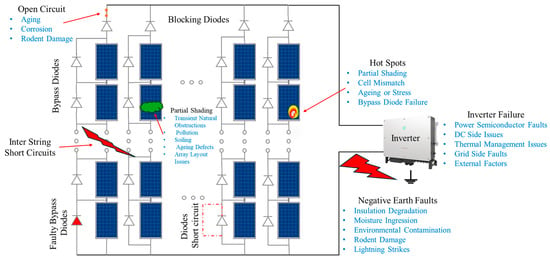
Figure 7.
Schematic representation of faults occurring on the DC side of a PV system.
4.1.2. AC-Side Faults
AC-side faults occur primarily at the inverter, transformer, and grid interface, impacting power conversion efficiency, grid stability, and overall system performance. One of the most frequent issues is inverter failure, which can stem from component degradation, excessive heat accumulation, or failure of the Maximum Power Point Tracking (MPPT) mechanism. Since inverters are responsible for converting DC power from PV modules into AC power for grid compatibility, their malfunction can lead to significant energy losses and system downtime. Another critical AC-side fault is transformer failure, commonly caused by overheating, insulation breakdown, or harmonics-induced stress. Transformers play a vital role in voltage regulation and power distribution, and any disruption in their function can result in inefficient power transmission, increased losses, or even a complete system shutdown [88]. Additionally, grid-related issues, such as voltage fluctuations, frequency instability, and power surges, can disrupt PV system operation. If grid parameters exceed the inverter’s operational limits, the inverter may disconnect automatically as a protective measure, leading to temporary system downtime and power quality issues. Moreover, variations in grid impedance and phase imbalances can cause harmonic distortions, reducing overall system efficiency and affecting nearby electrical equipment. To mitigate AC-side faults, advanced inverter protection mechanisms, thermal management solutions, predictive maintenance strategies, and real-time grid monitoring are employed. Implementing fault-tolerant inverter designs, improved grid synchronization techniques, and enhanced power electronics ensures more reliable and stable solar PV system operation.
4.1.3. Environmental and Degradation Faults
Solar PV systems are exposed to various environmental stressors that gradually degrade their performance and longevity. One of the most common issues is soiling, where dust, dirt, bird droppings, or other particulate matter accumulate on the surface of PV panels, reducing their ability to absorb sunlight efficiently. Regular cleaning schedules and self-cleaning coatings can help mitigate this issue. Corrosion and thermal stress are also major concerns, particularly in coastal or highly humid environments. Moisture ingress and salt deposits can lead to material degradation, impacting electrical contacts, frames, and junction boxes. Similarly, thermal cycling—constant expansion and contraction due to fluctuating temperatures—can create micro-cracks in solar cells, leading to hot spots, power losses, and potential long-term failure [89]. Figure 8 shows the degradation process through delamination.
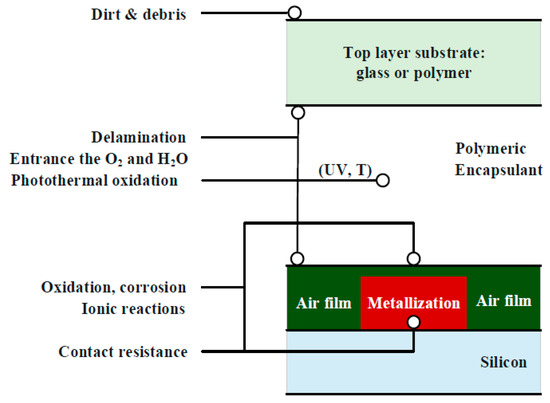
Figure 8.
Photovoltaic (PV) Module Degradation Mechanism Caused by the Delamination Process and Its Impact on Performance over Time [90].
A critical long-term degradation factor is potential-induced degradation (PID), which occurs due to high voltage differentials between the PV modules and grounding. This can cause a gradual leakage of charge, resulting in a significant decline in power output. The use of PID-resistant modules, optimized system grounding, and periodic voltage stress tests can help prevent this issue. Extreme weather conditions such as hailstorms, high winds, and heavy snowfall can cause physical damage to PV modules and structural failures in mounting systems. Strong winds can lead to misalignment or detachment of panels, while hail impact can result in glass fractures and reduced light absorption. Robust racking systems, tempered glass panels, and aerodynamic designs are essential for enhancing mechanical durability. To combat these environmental and degradation-related faults, advanced monitoring techniques such as thermal imaging, drone-based inspections, AI-powered predictive maintenance algorithms, and real-time performance tracking are increasingly adopted. These technologies enable early fault detection, preventive maintenance, and system optimization, ensuring higher reliability, extended operational lifespan, and improved efficiency of solar PV systems [82]. Figure 9 represents the visual representation of various factors that impact the power output of photovoltaic modules, leading to a gradual decline in performance over time.
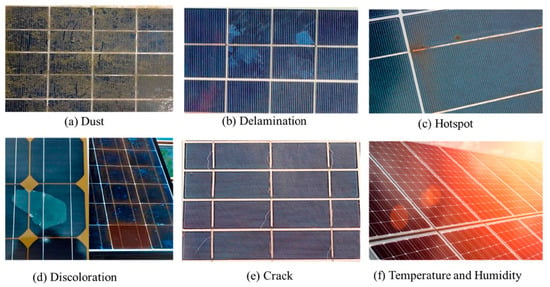
Figure 9.
Key Aging Factors Influencing the Longevity of Photovoltaic Modules: Insights from Laboratory Experiments and Original Sample Analysis [90].
4.1.4. Solar Panels Associated Fault
Like any other electrical system, solar PV panels are susceptible to various faults that can compromise their performance, efficiency, and longevity. These issues can arise due to manufacturing defects, installation errors, environmental exposure, or operational stresses. One of the most common faults is the formation of hot spots, which occur due to partial shading, poor soldering, or faulty bypass diodes. These localized overheated regions can significantly reduce efficiency and, in severe cases, cause thermal damage or even fire hazards [91]. Another critical issue is cell cracking, which can result from mechanical stress, thermal cycling, or poor handling during transportation and installation. These micro-cracks increase parasitic series resistance, limit power output, and accelerate degradation over time. Even minor cracks can eventually propagate and disconnect portions of the cell, further diminishing the system’s energy yield. Potential-Induced Degradation (PID) is another significant challenge in solar panels, occurring when high system voltage, moisture ingress, and improper grounding cause charge leakage. This leads to a gradual reduction in module efficiency and power loss, often requiring special anti-PID modules, optimized grounding techniques, or periodic voltage stress tests to mitigate the issue [92].
Poor material quality and prolonged exposure to UV radiation, high humidity, and extreme weather can lead to delamination and encapsulation failure. This weakens the protective layers of the panel, allowing moisture penetration, which can corrode internal components and reduce electrical insulation; ultimately accelerating module degradation [93]. Another common fault arises from the junction box and connector failures, which can occur due to poor installation, water pressure, or thermal stress. Faulty connections lead to open circuits, increased contact resistance, and reduced power output. If left unaddressed, these failures can further escalate, causing overheating, arcing, or electrical faults. To ensure the longevity and optimal performance of solar PV systems, regular maintenance, thermal imaging inspections, electroluminescence testing, and AI-driven fault diagnostics are essential. Early detection and timely repairs of these faults can significantly enhance system reliability, prevent safety hazards, and maximize energy yield, making proactive monitoring an indispensable part of solar PV system management [94,95]. Table 8 shows the Common Faults in Solar PV Systems, their Causes, and their Impacts, and Figure 10 shows the hotspots, cracks in the solar cell, and potential-induced degradation that are the most common reasons for degradation of PV modules.

Table 8.
Common Faults in Solar PV Systems: Causes and Impacts.
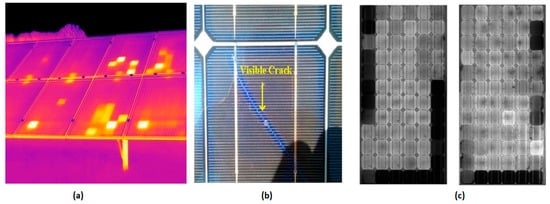
Figure 10.
(a) Hotspots, (b) cell cracks, and (c) Potential-Induced Degradation (PID) [91,92].
4.1.5. Electrical Faults
Electrical faults in solar PV systems can significantly impact efficiency, safety, and reliability. These faults typically arise due to poor installation, environmental exposure, material degradation, or operational stresses. If not addressed, they can lead to power losses, electrical hazards, or even fire risks. One of the most common electrical issues is open circuit faults, which occur when loose connectors, damaged wires, or faulty junction boxes interrupt the flow of current. This disruption causes affected modules or entire strings to lose power, leading to reduced energy generation and system inefficiencies. Ground faults occur when current unintentionally escapes into the ground due to insulation failure, moisture ingress, or improper wiring. These faults not only cause power losses but can also trigger inverter shutdowns, increase electric shock risks, and, in severe cases, cause fire hazards [96].
Arc faults are particularly dangerous as they involve high-energy discharges between damaged or loose electrical connections. They can result from corroded terminals, frayed wiring, poor crimping, or filter failures, creating plasma arcs that overheat components and increase fire hazards. In extreme cases, arcing faults may lead to explosions, transformer damage, or complete system failure. Additionally, tracking failures caused by electrical surges, extreme weather, or sudden voltage fluctuations can accelerate cable degradation and component wear, further elevating system vulnerability [97]. To minimize risks and enhance operational safety, modern solar PV systems integrate advanced arc fault detection systems (AFDD), ground fault interrupters (GFI), thermal imaging diagnostics, and AI-driven predictive maintenance. Implementing regular inspection protocols, ensuring high-quality electrical connections, and using fire-resistant materials can further reduce failure rates and improve system longevity [98]. Table 9 highlights the Electrical Faults in Solar PV Systems and their Causes and Impacts.

Table 9.
Electrical Faults in Solar PV Systems: Causes and Impacts.
4.1.6. Inverter and Power Electronics Failures
Inverters play a critical role in solar PV systems as they convert DC power from solar panels into AC power for grid compatibility. However, these components are prone to various faults that impact efficiency, reliability, and safety. Solar inverters rely on power semiconductor components such as MOSFETs, IGBTs (Insulated Gate Bipolar Transistors), and diodes. These components are susceptible to thermal stress, overvoltage conditions, and switching transients, which can cause cascade failures leading to burnouts, voltage spikes, or even complete inverter shutdowns. Excessive heat buildup due to poor ventilation, external temperature fluctuations, or electrical overloading can cause component degradation. Heat-related issues often result in inverter de-rating, power losses, and increased failure rates. Advanced liquid cooling and forced-air cooling systems can mitigate these effects and extend the inverter lifespan [99]. High-frequency switching operations in power electronics generate electromagnetic noise, which can interfere with communication systems, sensors, and control circuits. Poor filtering or improper shielding can lead to malfunctions in control logic, inaccurate power measurements, and instability in MPPT (Maximum Power Point Tracking) algorithms.
Inverter operation is dependent on firmware and control algorithms that regulate power conversion, synchronization, and protection mechanisms. Software errors, firmware bugs, or malfunctioning microcontrollers can result in inverter freeze, failure to track MPPT, or improper grid synchronization. Remote monitoring and AI-driven predictive diagnostics help detect and correct software anomalies. Defective feedback loops in transistor-controlled inverters lead to power fluctuations, harmonic distortions, and inefficiencies in power conversion [79]. Inverters must comply with grid codes to maintain power quality, and the use of advanced control strategies such as active harmonic filtering and reactive power compensation can reduce grid disturbances. To enhance the reliability and lifespan of solar inverters, several strategies should be implemented. Enhanced cooling systems, such as liquid cooling, heat sinks, and temperature monitoring, improve thermal management. Routine inverter maintenance ensures early fault detection by identifying wear and tear in critical components. Real-time remote monitoring systems allow operators to track inverter performance and detect issues before they escalate. The use of robust power electronics with improved surge protection and fault-tolerant designs strengthens inverter resilience against electrical disturbances [100]. The operational performance of inverters in different quadrants is depicted in Figure 11, while Table 10 summarizes inverter faults, their causes, and impacts.
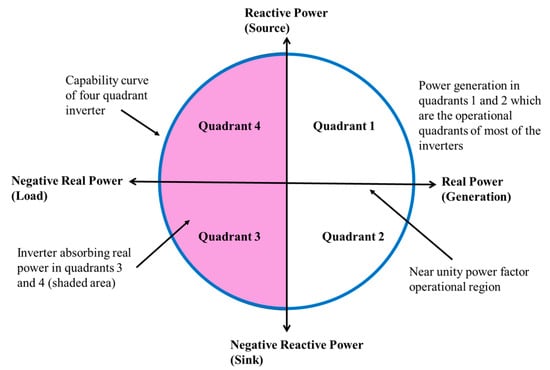
Figure 11.
Quadrants of inverter operation.

Table 10.
Inverter Faults in Solar PV Systems: Causes and Impacts.
4.1.7. Grid-Related Faults
Grid-connected solar PV systems face several operational challenges that can compromise both system efficiency and overall grid stability. One critical issue is islanding, which occurs when the grid experiences a shutdown, but the solar PV system continues to generate and supply power. This typically happens due to ineffective anti-islanding protection mechanisms. If utility workers or grid-connected appliances remain energized during this condition, it poses serious safety hazards, including electric shocks and equipment damage [101]. Implementing reliable anti-islanding detection methods, such as active and passive techniques, enhances system safety and ensures compliance with grid regulations. Voltage imbalances arise when the three-phase grid experiences unequal voltage levels across different phases. This imbalance is commonly caused by unbalanced loads, asymmetric grid faults, or inadequate power quality management. Such discrepancies lead to a drop in operational efficiency and an increased likelihood of inverter failure. If not properly managed, voltage imbalances can stress power electronic components, degrade performance, and disrupt grid synchronization. Advanced power electronics, real-time voltage monitoring, and phase-balancing techniques can mitigate these issues and improve system resilience [102].
Frequency instability is another major grid-related challenge. Grid disturbances, excessive generation from solar PV inverters, and variations in power consumption contribute to frequency deviations from the standard 50/60 Hz range. When grid frequency shifts beyond permissible limits, inverters may trip to prevent system damage, leading to power losses and reduced grid reliability. Adaptive frequency control mechanisms, grid-support functionalities in smart inverters, and energy storage integration help in stabilizing frequency fluctuations. To enhance the reliability of grid-connected solar PV systems, advanced grid monitoring technologies, robust anti-islanding protection, and adaptive inverter control strategies must be employed. These solutions ensure seamless integration of solar power while maintaining grid stability and operational efficiency [98]. Table 11 shows the Grid-Related Faults in Solar PV Systems and their Causes and Impacts, and Figure 12 shows the typical system configuration of islanding detection.

Table 11.
Grid-Related Faults in Solar PV Systems: Causes and Impacts.
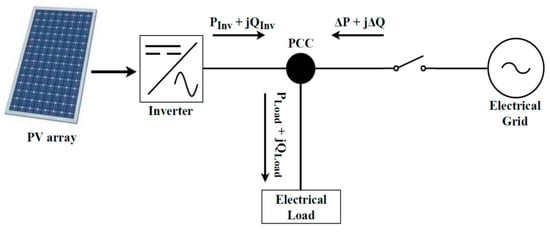
Figure 12.
Typical system configuration of islanding detection.
4.1.8. Environmental and Mechanical Failures
The performance and longevity of solar PV systems are significantly influenced by various environmental and mechanical factors. One major concern is soiling, which occurs due to the accumulation of dust, dirt, bird droppings, and pollutants on the panel surface. This layer obstructs sunlight absorption, reducing energy output and increasing maintenance costs. Over time, excessive soiling can lower system efficiency and require frequent cleaning to restore optimal performance. Shading caused by trees, buildings, and passing clouds, along with module mismatches, further impacts solar energy generation. In addition to lowering power output, shading can contribute to the formation of hotspots, which degrade solar cells and may lead to irreversible damage [103].
Extreme weather conditions pose another serious challenge to solar PV installations. Hailstorms, heavy snow, and prolonged exposure to rainfall can cause mechanical damage to panels, leading to micro-cracks or even complete breakage. Strong winds may also destabilize the mounting structures, potentially resulting in displacement or total system failure. Additionally, solar panels installed in coastal or highly humid regions are susceptible to corrosion and rusting, which weaken both the module frames and mounting structures. Exposure to saltwater and the use of substandard materials further accelerate degradation, increasing the risk of electrical shorts and compromised structural integrity [104].
To mitigate these environmental and mechanical failures, preventive measures such as routine cleaning, the application of anti-soiling and protective coatings, and the use of corrosion-resistant materials in system components are essential. Employing robust mounting structures designed to withstand high wind loads, using high-quality encapsulation materials, and integrating automated monitoring systems for early fault detection can significantly enhance the durability and efficiency of solar PV installations [105]. Table 12 represents the Environmental and Weather-Related Faults in Solar PV Systems and their Causes and Impacts, while Figure 13 represents the different environmental factors affecting the solar PV output.

Table 12.
Environmental and Weather-Related Faults in Solar PV Systems: Causes and Impacts.
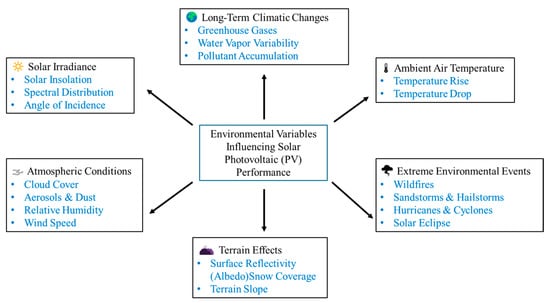
Figure 13.
Different environmental factors affecting the solar PV output.
4.2. Impact of Faults on System Performance and Safety
Faults in grid-connected solar photovoltaic (PV) systems can significantly compromise both performance and safety, leading to operational disruptions and increased risks. These faults, if left unaddressed, not only reduce the overall energy output but also impact system reliability and longevity. Beyond the immediate loss of efficiency, prolonged exposure to system faults can accelerate component degradation, leading to more frequent maintenance cycles and higher operational expenses. Electrical failures such as ground faults, arcing faults, and insulation breakdowns increase the risk of fire and electrical shocks, making robust safety protocols essential [106]. Additionally, the potential for cascading failures within interconnected PV networks highlights the need for early detection and rapid response mechanisms. Implementing proactive fault detection strategies, such as real-time monitoring, predictive maintenance using AI-based analytics, and compliance with stringent grid regulations, can mitigate risks and enhance overall system resilience. Effective damage control measures, including smart inverters, improved circuit protection, and thermal management systems, help prevent catastrophic failures while ensuring sustainable and efficient solar PV operation [107].
4.2.1. Effect on Performance Output
Faults in both grid-connected and standalone solar PV systems significantly impact performance output, with power loss being one of the most critical concerns. Electrical faults such as open circuits, short circuits, and ground faults disrupt the normal flow of electricity, reducing the conversion of solar energy into usable electrical power. Additionally, shading caused by obstructions like trees, buildings, and accumulated debris can drastically lower solar radiation absorption, leading to a sharp decline in power generation. Even minor shading on a small portion of a panel can cause a disproportionate loss of output by disrupting the coordination of multiple modules, further diminishing system performance.
Efficiency degradation is another major issue, exacerbated by aging components and environmental factors. Over time, solar panels experience voltage loss due to prolonged exposure, while potential-induced degradation (PID) can accelerate performance decline. Overheating of system components, particularly inverters and connectors, increases electrical impedance, reducing overall efficiency [80]. Harmonic distortions, primarily originating from inverter malfunctions, introduce unwanted electrical frequencies into the system, which can propagate through the grid and interfere with other electrical devices. Excessive harmonics resulting from inverter failure may cause voltage and current fluctuations, reducing energy efficiency and posing a risk to sensitive grid-connected equipment [108]. Another critical challenge is grid instability, as solar PV power plants must maintain consistent voltage and frequency levels. Frequency drift and voltage swings, caused by improper load distribution or faulty connections, can lead to inverter tripping if grid frequency deviates from the nominal 50 Hz or 60 Hz range, resulting in immediate power loss [81]. These disruptions ultimately decrease overall system effectiveness, underscoring the need for enhanced monitoring, grid-supportive inverters, and advanced fault detection mechanisms.
4.2.2. Concerns on Safety
Beyond performance concerns, faults in solar PV systems pose significant safety risks, with fire hazards being among the most critical threats. Electrical faults, particularly arc faults, can occur due to broken or loose connections within the circuit. These faults generate excessive heat, potentially igniting surrounding combustible materials. Large-scale solar installations are particularly vulnerable, as poor-quality electrical connections combined with inverter overheating can escalate the risk of fire incidents [83]. Another major safety risk is the potential for electric shock hazards, which can endanger both workers and system users. Damaged wires and connectors increase the likelihood of accidental exposure to high-voltage currents. In utility-scale PV systems operating at elevated voltage levels, even minor faults can result in severe injuries or fatalities. Ensuring proper grounding, insulation, and the use of arc-fault detection mechanisms is crucial in mitigating these risks. Additionally, failure to address faults on time can lead to long-term equipment damage, further compromising system integrity and safety [84]. Implementing stringent maintenance protocols and incorporating advanced protective technologies is essential to enhance the overall safety and reliability of solar PV systems.
4.2.3. Faults and Maintenance in Solar PV Systems
Solar photovoltaic (PV) systems are continuously exposed to environmental and operational stressors that can degrade their performance over time. Factors such as voltage fluctuations, excessive heat, and moisture accumulation can accelerate component wear, leading to costly repairs or even complete system failure [109]. If these faults go undetected, they not only increase maintenance costs but also reduce return on investment (ROI). Grid-connected solar PV systems face specific operational challenges that impact both energy efficiency and system security. Power losses, efficiency degradation, and electrical disturbances can trigger system faults, while fire hazards and electric shock risks pose serious threats to both users and infrastructure. Such incidents can cause irreversible damage to critical components, undermining overall system reliability.
To enhance efficiency and long-term stability, continuous monitoring and proactive maintenance of solar PV systems are essential. Advanced fault detection techniques, including real-time monitoring, predictive analytics, and automated diagnostics, help identify failures before they escalate, minimizing costly downtime and operational disruptions [70]. By integrating intelligent maintenance strategies and robust protection mechanisms, solar PV systems can significantly reduce fault occurrences, ensuring enhanced safety, reliability, and optimal energy production. Various types of defects may affect the functionality, safety, and energy production of photovoltaic (PV) systems on the electrical, mechanical, and environmental levels. Faulty balance-of-system components, strings, individual modules, inverters, and even wiring or protection devices may cause these fault mechanisms. The implementation of pertinent diagnosis methods to advance the early identification of these defects is important to predict maintenance and improve the overall reliability of the systems. The classification of diagnostic techniques according to their analysis domain and input signal types consists of electrical, thermal/optical, and data-driven techniques. An overview of the main techniques and their uses is presented in Table 13.

Table 13.
Summary of Diagnostic Techniques for PV System Fault Detection.
5. Fault Diagnosis and Predictive Maintenance Approaches
As the implementation of solar photovoltaics increases, solving problems surrounding dependability and reliability in terms of performance becomes a challenge. Defects in solar systems amplify energy losses, associated costs, safety issues, and repair costs. Predictive maintenance and fault diagnosis techniques help tackle these problems effectively. These techniques are based on constant surveillance of system performance to diagnose potential failures and minimize system unavailability [77]. There are many approaches in the literature that deal with the diagnosis of solar PV system faults, from classical inspection approaches to modern AI-driven approaches.
5.1. Traditional Diagnostic Techniques
Conventional methods of fault detection of solar systems have been in use for a long time. These consist of routine inspection of the operating systems in addition to their usage, for example, infrared tests that provide remote sighted control for system performance abnormalities.
- Detailed panel inspection techniques.
- Infrared thermography for panel inspection.
- I-V curve tracing for module performance analysis.
- Ground fault detection methods.
5.1.1. Physical Panel Inspection
A manual inspection is one of the easiest techniques that can be employed to identify faults in solar PV systems. It comprises a visual examination of solar panels and looks for cracks, dust, discoloration, and loose connections along the edges of the PV Cells. Constant monitoring also assists in identifying damage from the environment, like hailstorms, dirt, or extreme environmental temperatures. Although this approach takes time and effort, it is a critical part of proactive maintenance of the equipment [110].
5.1.2. Infrared Thermography
This is a contactless technique used in seeking hidden faults in solar panels. It involves the scanning of solar modules with thermal cameras for hot spots that are indicative of faulty cells, defective solder joints, or electrical imbalance. This method has great potential in finding problems that are hidden and cannot be found through check-ups at the surface level [111]. Figure 14 shows the photograph and thermal image of the photovoltaic (PV) panel, illustrating both healthy and faulty modules, with a temperature scale bar, color mapping, and a label indicating the typical hotspot temperature threshold (>60 °C) to enhance interpretability and visual clarity.
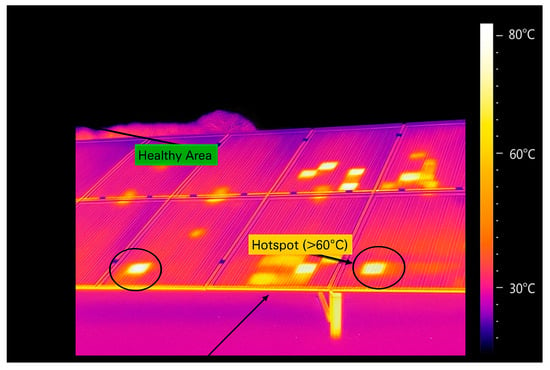
Figure 14.
Thermal image of PV panels showing hotspot region (>60 °C) and healthy cell areas for comparison.
5.1.3. I-V Curve Tracing
Solar panels are tested using I-V (Current–Voltage) curve tracing, which is an electric method that analyzes their performance and determines the amount of current and voltage being produced. This method identifies problems like shading, cell deterioration, or even broken bypass diodes. The well-being of solar modules and their efficiency is best illustrated in an I-V curve [71]. The relationship between current and voltage produced by a solar cell is based on the Shockley diode equation, reflecting the amount of sunlight globally. The I-V curve can be analyzed to evaluate efficacy and diagnose potential concerns in a solar module. A standard I-V curve analysis of a solar cell is illustrated in Figure 15.
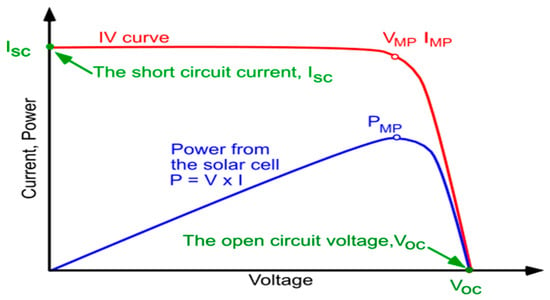
Figure 15.
I-V curve analysis of a solar cell.
In the above equation, is the output of the solar cell (A), Is he photocurrent (light-generated current) (A), Reverse saturation current of the diode (A), is the charge of an electron, is the applied voltage is the Boltzmann constant, is the ideality factor (typically between 1 and 2), and is the absolute temperature in Kelvin (K).
5.1.4. Ground Fault Detection Methods
Ground faults are defined as electrical currents that drain unintentionally to the ground because of disordered insulation or shredded wires. The traditional obstacles for locating ground faults are insulation resistance testers and ground fault indicators. These approaches help curb the dangers of electric shock while improving system safety.
5.2. AI and Machine Learning-Based Fault Detection
5.2.1. Data-Driven Predictive Maintenance Approaches
In the traditional approaches for detecting ground faults using insulation resistance testers and ground fault detectors, there has been substantial integration towards enhancing overall system safety and guarding against electric shock. Nonetheless, these methods have been quite rudimentary until new technologies offered better alternatives. AI and ML have completely transformed the domains of predictive maintenance and fault diagnostics in solar PV systems [112]. It automates fault detection, allowing for faster intervention while reducing human resource availability for most faults. Real-time data is converted to information through pattern recognition for discrepancy detection and failure forecasting. This advance in AI brings more autonomy and reliability to systems, besides optimizing maintenance activities to ensure more uptime and efficient operation of solar PV installations. This method improves system dependability and productivity while optimizing maintenance activities to lower operational expenditures. The integration of AI and ML makes it possible to achieve higher solar PV system performance, durability, and efficiency, which facilitates a shift towards sustainable energy sources [85].
5.2.2. Feature Extraction and Classification Techniques for Fault Diagnosis
Of all the areas of AI development that were previously mentioned, the most popular ones among design, forecasting, control, and maintenance are discussed in great detail in the literature. The components of cybersecurity are emerging and are viewed as the expected developments of AI in the future for PV power systems. The improvements in the working data of PV power systems have created the need for the development of AI to help the systems automate the design, control, and maintenance processes aimed at improving efficiency and minimizing response time. Such an approach motivated the research efforts from a data-driven point of view to the study of AI in control systems of power engineering complex systems [113]. Figure 16 shows the relationship between the function and the application of AI technologies in power systems employing different artificial intelligence strategies, including design, forecasting, control, and maintenance.
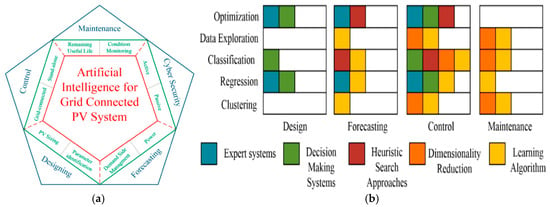
Figure 16.
(a) Application of artificial intelligence for power systems; (b) Generalization of different AI applications for the design, control, forecasting, and maintenance of grid-tied PV systems.
5.2.3. An Approach Towards Predictive Maintenance Using Data
Utilizing AI for anticipating machine failures involves analyzing both real-time and past data. This approach facilitates early fault identification, minimizes machine downtime, improves the optimization of maintenance windows, and enhances the reliability and efficiency of the entire system. Predictive modeling can analyze power output trends together with the temperature and electrical parameters to prevent failures from happening and thus enhance system reliability as well as reduce downtime [114].
5.2.4. Techniques of Feature Extraction and Classification Used in Fault Diagnosis
Machine learning enables the classification of faults using assistive feature extraction techniques with voltage, current, and temperature parameters. Extracted features are divided into various fault classes that allow accurate identification of the faults [115].
5.3. Monitoring the Physical Condition Using Digital Twins
Real-time information is used to adjust a digital model of a solar PV system, known as a twin in the context of a real twin. The monitoring, anomaly detection, and performance simulation offer digital twins to proactively maintain and optimize solar PV plants [116].
5.4. IoT and Smart Monitoring Systems
The collection of data remotely from solar PV systems through the use of the Internet, known as the Internet of Things (IoT), drastically enhances the monitoring accuracy of the systems. Predictive maintenance utilizing IoT technologies enhances the efficiency of fault detection and reduces operational costs [117].
5.4.1. Role of IoT in Real-Time Fault Detection
Performance monitoring of PV modules, inverters, and weather stations is performed using IoT-enabled sensors with the ability to collect data continuously. These data-collecting sensors send information to cloud platforms where fault trends and forecasts are analyzed by AI. With real-time fault detection, corrective measures can be taken instantaneously, therefore decreasing downtime [78].
5.4.2. Cloud-Based Predictive Analytics for Grid-Connected Solar Plants
Solar plants use a cloud-based analytical platform, which enables the storage and analysis of large datasets for predictive analytics. These platforms apply algorithms through machine learning to predict faults, optimize energy generation, and suggest maintenance periods. With the use of a cloud, solar photovoltaic systems can stay functional with little to no manual work needed to be performed [67].
5.5. Fault Detection Methods for Predictive Maintenance
Integrated solar photovoltaic (PV) systems are paramount to the evolution of solar-based energy systems. Just like any other electrical system, grid-connected solar systems also have a few faults and failures that may affect their performance and reliability. Now, with the increasing deployment of these systems, ensuring their sustained performance over a long duration becomes the main concern [74]. The term reliability in the context of a solar PV system refers to its ability to perform within nominal conditions for a given time. However, it is important to note that most solar PV system failures can result from severe environmental conditions, aging parts, electrical anomalies, and natural deterioration over time and use [68]. Rather than waiting for a failure to take place and correcting it (as in traditional maintenance), predictive maintenance attempts to monitor the condition of the system and identify potential failures well in advance. This is achieved through sophisticated tools like data analytics, artificial intelligence (AI), and the Internet of Things (IoT) [75]. These can identify minor damage before it proliferates into more serious problems, thereby minimizing disruption and repair costs.
In [73], the authors made an intelligent system that implements machine learning models for the recognition of different forms of failures within PV systems. Researchers developed an algorithm related to solar panels in [118], coming up with the real-time visibility approach. They formed a known set of monitored failure conditions and periodically evaluated system performance for fault detection. In [76], the Researchers proposed dependability of PV inverters is significant and analyzed the performance of the inverters, which are key components in solar systems, using statistical techniques and machine learning. In [119], the authors suggested improved methods of defect detection involving a hybrid method that integrates electrical and thermal measurements. This technique aids in identifying overheating (hotspots) and other failures in solar panels so that corrective actions may be taken with minimal delay. In [72], the authors developed a deep learning model that is trained on historical data to predict failures and optimize maintenance schedules. In [69], the author proposed an abnormality detection method, while Fourier transform feature extraction is applied for signal analysis of PV systems. In [120], the author proposed a framework for remote monitoring and fault detection of large PV plants through IoT devices to diagnose abnormal conditions in PV systems. In [121], the authors developed a model competition strategy where several machine learning models were trained to find the most efficient one for solar system fault detection. They systematically compared and contrasted several models to select the most accurate fault detection algorithm.
6. Strategies for Enhancing the Reliability of Grid-Connected Solar Systems
The reliability of grid-connected solar PV systems is increasingly being enhanced through predictive maintenance, smart monitoring, and advanced protection schemes. According to recent industrial case studies and academic reports, predictive maintenance has been shown to reduce maintenance costs by approximately 25–30% and enhance energy yield or system efficiency by 15–20%. While traditional methods such as thermography, visual inspection, and I-V curve tracing remain relevant, the application of tools like AI, ML, IoT, and cloud-based analytics has further increased system resilience while minimizing costs and downtime. Table 14 provides a summary of fault diagnosis and predictive maintenance techniques.

Table 14.
The summary of fault diagnosis and predictive maintenance techniques.
The incorporation of grid-connected solar PV systems has been made more reliable and efficient due to advancements in predictive maintenance and fault detection. Previous techniques, including thermal imaging, panel inspections, and I-V curve tracing, are still essential in problem detection. With changes in solar PV technology, intelligent monitoring systems will need to be incorporated to maintain the sustainability of solar energy over time. Operators will be equipped with new tools to enhance system performance and mitigate risks while improving profits. A fault-tolerant PV system needs to be designed if performance losses need to be minimized and maintenance costs reduced. Modern PV systems should also be able to withstand environmental and electrical or mechanical stresses that cause failure and system inefficiencies. Centralized inverters are vulnerable to single-point failures. System reliability is increased as each panel can operate independently with micro-inverters and power optimizers, thereby decreasing energy loss from partial shading or module failures. Exceeding operating temperatures is a typical challenge faced with solar photovoltaic (PV) systems, especially concerning inverters and power electronics.
Anti-islanding protection (AIP) is a pertinent security feature of grid-connected solar photovoltaic systems whose primary purpose is to stop the generation of electricity whenever there is a power failure or outage. In the event of an outage, if a solar system continues to be active, it puts utility workers trying to restore power into risky situations since systems may still be enabled to inject power into the grid. Anti-Islanding Protection identifies system failures and automatically disables the active solar power inverter to stop any unintentional electricity flow. Unlike the rest of the technologies, AIP employs advanced detection methods that include frequency and voltage monitoring, passive and active islanding detection, and rapid disconnection techniques. By disabling the capability of solar photovoltaic systems to continue being supplied with power in the event of grid failures, AIP enhances the security of the system and stability in the grid. PV systems may be subjected to external effects such as grid surges and lightning strikes. Damages because of these phenomena may be diminished by the use of Grounding and Surge Protective Devices (GSPDs) for such instances. Discharge caused by lightning strikes may affect the inverter, PV modules, and other system components adversely. Surges by voltage at different places in the system can be blocked by the sensitive electronics placed at critical points. Table 15 highlights the Consolidated Strategies for Enhancing the Reliability of Grid-Connected Solar PV Systems.

Table 15.
Consolidated Strategies for Enhancing the Reliability of Grid-Connected Solar PV Systems.
6.1. Quantitative Analysis Tables for PV Faults and Diagnostics
In this section, analytical insights are presented in the form of quantitative information obtained from several studies focusing on average energy losses, contributions to failures, and diagnostic accuracies concerning grid-connected PV systems. Table 16 highlights the typical PR and energy losses for major PV degradation/fault types, and Table 17 illustrates the average level of accuracy in fault detection associated with three widely employed diagnostic techniques: infrared (IR) thermography, electroluminescence (EL) imaging, and electrical-signal analysis, based on numerous studies in literature. EL imaging stands out in this group with a mean accuracy of 96.2%, as it is highly sensitive to detecting microcracks, potential-induced degradation, and cell-level defects. IR thermography is somewhat comparable. Although it is marginally less accurate, with 93.4%, it has faster field applicability, while the electrical-signal analysis, due to the environmental effects on signals and noise in the background, is cost-effective, but somewhat less accurate, yielding an average of 90.1%. The reported standard deviations as well as the 95% confidence intervals attest to the diagnostic approaches’ consistency and dependability across varying field conditions of PV systems.

Table 16.
Typical PR and energy losses for major PV degradation/fault types.

Table 17.
Comparative fault detection accuracy across diagnostic techniques.
6.2. Review Methodology and Data Synthesis
For the sake of clarity in the quantitative synthesis in Table 15 and Table 16, means and standard deviations were either taken directly from the studies included or calculated from the available figures. Using a random-effects model, the pooled estimates and 95% confidence intervals (CIs) were determined. Variability across the studies was taken into consideration. Sample-size weighting was utilized so that larger studies proportionately contributed more to the pooled estimates. The heterogeneity across the studies was evaluated by counting the studies that contributed to each row and, where appropriate, computing the I2 statistic. This process of combining studies is clear and reproducible, providing the readers with confidence in the reported pooled PR/energy losses and diagnostic accuracies.
7. Discussion and Future Directions
7.1. Summary of Key Findings
Like any system, grid-connected solar photovoltaic (PV) systems are critical in clean energy development and are subject to faults and failures that affect overall performance and safety. This review discussed the existing faults in solar PVs, the types being: solar panel-associated faults, electrical faults, inverter faults, grid faults, and environmental faults. These faults lead to power losses but also constitute a range of severe hazards, including fire risks, electric shock, and equipment damage. Solving these problems for good fault detection methods, predictive maintenance strategies, and reliability improvement actions are required. Routine diagnosis methods, such as infrared thermography, I-V curve tracing, or ground fault detection, still hold merit in overcoming system failure. However, modern methods that utilize Artificial Intelligence (AI), machine learning, and IoT have further advanced the reliability and accuracy of fault diagnosis as well as predictive maintenance. Moreover, real-time anomaly detection and predictive analysis improve system reliability and reduce operation costs. Furthermore, advanced protection schemes, proactive maintenance, and fault-tolerant designs greatly improve the stability of grid-integrated solar PV systems.
7.2. Opportunities and Challenges for Future Research
There has been considerable progress made in autonomic fault diagnosis and predictive maintenance; however, the reliability and efficiency of grid-connected solar PV systems remain a challenge. One of the major challenges includes the high cost of monitoring systems that employ AI analytics and IoT-based applications. Many small to medium-scale solar installations do not have the financial capabilities to implement these technologies, which hinders their ability to proactively monitor and manage faults. Future efforts should seek to create more affordable diagnostic devices that can be incorporated into pre-existing solar power infrastructure. Remotely hosted and cloud-based diagnostic tools can also significantly overlook the challenges involved with data interpretation, as these all-in-one solutions provide complete systems. For AI and machine learning models to deliver accurate predictive maintenance algorithms, trained datasets must be large. Unfortunately, there is substantial difficulty in attaining high-fidelity labeled data for specified fault scenarios. The gaps in data collection techniques and the lack of standard datasets are impediments to effective fault detection modeling. Finally, increasing the explainability and transparency of AI-enabled diagnostics will enhance trust and reliance on automation-assisted fault detection systems.
Adding renewable energy sources to the power grid brings more issues concerning grid stability and coordination. With an increased share of solar power, grid operators need to enhance control strategies for managing voltage disturbances, frequency shifts, and power quality issues caused by faults in PV systems. Research is also needed on intelligent grid integration techniques such as smart inverters, microgrid systems, and diffuse adaptive control algorithms to improve the power system resiliency of solar PV installations. Another possibility includes real-time condition monitoring using digital twins. Digital twin technology refers to the automated production of PV system replicas and their performance simulations under preset scenarios. Operators can constantly update the digital twin with data to predict failures and optimize maintenance and overall system performance. More work is needed to validate the digital twin model parameters for solar PV systems to ensure proper diagnosis.
7.3. Recommendations for Policies and Industry to Enhance the Reliability of Grid-Integrated Solar Power Systems
Policymakers and stakeholders in the solar energy sector should adopt multidisciplinary approaches aimed at solving reliability adoption issues for grid-connected solar photovoltaics. Government policy should offer incentives aimed at encouraging the adoption of modern predictive maintenance and monitoring systems. Tax credits and grants can enable small solar power operators to employ IoT monitoring and AI fault detection systems. Methodology standardization for fault detection and performance evaluation across the solar value chain should be the next important step. Regulators should develop data collection, fault type, and maintenance procedure standards to ensure that the diagnosis and healing of PV system failures are well performed. From an industrial perspective, the focus should shift towards making more reliable and rugged solar components. New material technologies like self-cleaning solar panel coatings and better thermal management for inverter components could increase the lifetime and performance of PV installations. To accommodate the growing consumption of solar energy, utility companies and grid operators need to implement sophisticated grid management techniques. The implementation of demand-side management, energy shifting, and distributed generation mitigates the effects of PV system faults on the grid. Advanced solar power integration will largely depend on smart grid infrastructure with pre-/post-mortem self-healing and fault detection disk functionality.
8. Conclusions
The integration of solar photovoltaic (PV) systems into power networks is progressing, and so is renewable energy generation. However, the reliability, efficiency, and safety of grid-connected solar PV systems are constantly under scrutiny because of the different faults and failures that may occur. This review has given a thorough assessment of the most concerning issues of PV systems, which include panel degradation, electrical faults, inverter failure, and grid malfunctions. These flaws result in low energy conversion and high-power loss while also creating dangerous conditions of fires and electric shocks. Thus, accurate fault identification and predictive maintenance strategies should be developed if system performance and the life duration of solar PV systems are to be improved. Common diagnostic procedures like infrared thermal imaging and IV curve analysis are proactive and identify system abnormalities, but do not provide preventative assistance. Most of the time, these techniques find problems only after they have already damaged system functionality. There needs to be a shift towards advanced fault detection and predictive maintenance solutions to keep up with the rise in demand for solar energy. Moreover, the sustainability of solar PV systems requires continuous innovation and research in fault detection methodologies to make them reliable. The implementation of drones for thermal imaging, electroluminescence imaging, active I-V tracking, and others can solve the problem of hybrid detection by automating defect detection. Also, inverter producers and suppliers have begun implementing self-diagnostic functions that recognize abnormal behavior and start self-defense actions. With technological progress comes the necessity for policy frameworks and regulatory standards to be adopted in support of maintenance forecasting and fault prediction in Solar PV systems. Capture markets with so-called smart monitoring systems and sponsor the development of intelligent energy management systems. Along with researchers and solar stakeholders, utility companies need to work together to develop standard failure classification systems that complement fault identification and system protection. In summary, grid-connected solar PV systems will need sophisticated fault monitoring, predictive maintenance, and monitoring for everything to work together seamlessly. Helping with predictive maintenance will improve the efficiency, reliability, and safety of solar PV installations, keeping them sustainable long-term. With these techniques, solar energy can keep transitioning toward a resilient, clean, and sustainable energy future.
Author Contributions
Conceptualization, M.A.K. and K.K.; methodology, K.K.; software, M.A.K.; validation, K.K., B.A. and M.U.N.; formal analysis, T.V.; investigation, A.K. and K.K.; resources, K.K.; data curation, M.A.K.; writing—original draft preparation, M.A.K. and K.K.; writing—review and editing, B.A.; visualization, B.A.; supervision, T.V. and A.K. All authors have read and agreed to the published version of the manuscript.
Funding
This research received no external funding.
Institutional Review Board Statement
Not applicable.
Informed Consent Statement
Not applicable.
Conflicts of Interest
Author Karl Kull was employed by the company Evecon OÜ. The remaining authors declare that the research was conducted in the absence of any commercial or financial relationships that could be construed as a potential conflict of interest.
References
- Nwaigwe, K.; Mutabilwa, P.; Dintwa, E. An overview of solar power (PV systems) integration into electricity grids. Mater. Sci. Energy Technol. 2019, 2, 629–633. [Google Scholar] [CrossRef]
- Jiménez-Torres, M.; Rus-Casas, C.; Lemus-Zúiga, L.G.; Hontoria, L. The Importance of Accurate Solar Data for Designing Solar Photovoltaic Systems—Case Studies in Spain. Sustainability 2017, 9, 247. [Google Scholar] [CrossRef]
- Hayat, M.B.; Ali, D.; Monyake, K.C.; Alagha, L.; Ahmed, N. Solar energy—A look into power generation, challenges, and a solar-powered future. Int. J. Energy Res. 2019, 43, 1049–1067. [Google Scholar] [CrossRef]
- Du, E.; Zhang, N.; Hodge, B.-M.; Wang, Q.; Kang, C.; Kroposki, B.; Xia, Q. The role of concentrating solar power toward high renewable energy penetrated power systems. IEEE Trans. Power Syst. 2018, 33, 6630–6641. [Google Scholar] [CrossRef]
- Khan, J.; Arsalan, M.H. Solar power technologies for sustainable electricity generation—A review. Sustain. Energy Rev. 2016, 55, 414–425. [Google Scholar] [CrossRef]
- Sangswang, A.; Konghirun, M. Optimal Strategies in Home Energy Management System Integrating Solar Power, Energy Storage, and Vehicle-to-Grid for Grid Support and Energy Efficiency. IEEE Trans. Ind. Appl. 2020, 56, 5716–5728. [Google Scholar] [CrossRef]
- Zhang, C.; Xia, J.; Guo, X.; Huang, C.; Lin, P.; Zhang, X. Multi-optimal design and dispatch for a grid-connected solar photovoltaic-based multigeneration energy system through economic, energy and environmental assessment. Sol. Energy 2022, 243, 393–409. [Google Scholar] [CrossRef]
- Bamisile, O.; Acen, C.; Cai, D.; Huang, Q.; Staffell, I. The environmental factors affecting solar photovoltaic output. Renew. Sustain. Energy Rev. 2025, 208, 115073. [Google Scholar] [CrossRef]
- Sayed, A.; El-Shimy, M.; El-Metwally, M.; Elshahed, M. Reliability, Availability and Maintainability Analysis for Grid-Connected Solar Photovoltaic Systems. Energies 2019, 12, 1213. [Google Scholar] [CrossRef]
- Tawfiq, A.A.E.; El-Raouf, M.O.A.; Mosaad, M.I.; Gawad, A.F.A.; Farahat, M.A.E. Optimal Reliability Study of Grid-Connected PV Systems Using Evolutionary Computing Techniques. IEEE Access 2021, 9, 42125–42139. [Google Scholar] [CrossRef]
- Sarita, K.; Saket, R.; Khan, B. Reliability, availability, and condition monitoring of inverters of grid-connected solar photovoltaic systems. IET Renew. Power Gener. 2023, 17, 1635–1653. [Google Scholar] [CrossRef]
- Cai, B.; Liu, Y.; Ma, Y.; Huang, L.; Liu, Z. A framework for the reliability evaluation of grid-connected photovoltaic systems in the presence of intermittent faults. Energy 2015, 93, 1308–1320. [Google Scholar] [CrossRef]
- Sayed, A.; El-Shimy, M.; El-Metwally, M.; Elshahed, M. Impact of subsystems on the overall system availability for the large scale grid-connected photovoltaic systems. Reliab. Eng. Syst. Saf. 2020, 196, 106742. [Google Scholar] [CrossRef]
- Livera, A.; Theristis, M.; Makrides, G.; Georghiou, G.E. Recent advances in failure diagnosis techniques based on performance data analysis for grid-connected photovoltaic systems. Renew. Energy 2019, 133, 126–143. [Google Scholar] [CrossRef]
- Zeb, K.; Islam, S.U.; Khan, I.; Uddin, W.; Ishfaq, M.; Busarello, T.D.C.; Muyeen, S.; Ahmad, I.; Kim, H. Faults and Fault Ride Through strategies for grid-connected photovoltaic system: A comprehensive review. Renew. Sustain. Energy Rev. 2022, 158, 112125. [Google Scholar] [CrossRef]
- Malik, A.; Haque, A.; Kurukuru, V.B.; Khan, M.A.; Blaabjerg, F. Overview of fault detection approaches for grid connected photovoltaic inverters. e-Prime Adv. Electr. Eng. Electron. Energy 2022, 2, 100035. [Google Scholar] [CrossRef]
- Singh, S.; Saket, R.K.; Khan, B. A comprehensive review of reliability assessment methodologies for grid-connected photovoltaic systems. IET Renew. Power Gener. 2023, 17, 1859–1880. [Google Scholar] [CrossRef]
- Kolawole, M.I.; Ayodele, B.L. Smart electronics in solar-powered grid systems for enhanced renewable energy efficiency and reliability. Int. J. Sci. Res. Arch. 2024, 13, 2910–2930. [Google Scholar] [CrossRef]
- Thomas, G.A.S.; Muthukaruppasamy, S.; Saravanan, K.; Muleta, N. Revolutionizing Smart Grids with Big Data Analytics: A Case Study on Integrating Renewable Energy and Predicting Faults. In Data Analytics for Smart Grids Applications—A Key to Smart City Development; Springer: Berlin/Heidelberg, Germany, 2023; pp. 179–198. [Google Scholar] [CrossRef]
- Abubakar, A.; Almeida, C.F.M.; Gemignani, M. Review of Artificial Intelligence-Based Failure Detection and Diagnosis Methods for Solar Photovoltaic Systems. Machines 2021, 9, 328. [Google Scholar] [CrossRef]
- Kandeal, A.; Elkadeem, M.; Thakur, A.K.; Abdelaziz, G.B.; Sathyamurthy, R.; Kabeel, A.; Yang, N.; Sharshir, S.W. Infrared thermography-based condition monitoring of solar photovoltaic systems: A mini review of recent advances. Sol. Energy 2021, 223, 33–43. [Google Scholar] [CrossRef]
- Abro, G.E.M.; Ali, A.; Memon, S.A.; Memon, T.D.; Khan, F. Strategies and Challenges for Unmanned Aerial Vehicle-Based Continuous Inspection and Predictive Maintenance of Solar Modules. IEEE Access 2024, 12, 176615–176629. [Google Scholar] [CrossRef]
- Amir, M.; Prajapati, A.K.; Refaat, S.S. Dynamic Performance Evaluation of Grid-Connected Hybrid Renewable Energy-Based Power Generation for Stability and Power Quality Enhancement in Smart Grid. Front. Energy Res. 2022, 10, 861282. [Google Scholar] [CrossRef]
- Constantin, A.-I.; Iosif, G.; Chihaia, R.-A.; Marin, D.; ABU Shehadeh, G.U.; Karahan, M.; Gerikoglu, B.; Stavrev, S. Importance of Preventive Maintenance in Solar Energy Systems and Fault Detection for Solar Panels based on Thermal Images. Electroteh. Electron. Autom. 2023, 71, 1–12. [Google Scholar] [CrossRef]
- Afridi, Y.S.; Ahmad, K.; Hassan, L. Artificial intelligence based prognostic maintenance of renewable energy systems: A review of techniques, challenges, and future research directions. Int. J. Energy Res. 2022, 46, 21619–21642. [Google Scholar] [CrossRef]
- Kumar, R.; Mishra, S.K.; Sahoo, A.K.; Swain, S.K.; Bajpai, R.S.; Flah, A.; Almalki, M.M.; Kraiem, H.; Elnaggar, M.F. Data driven prediction based reliability assessment of solar energy systems incorporating uncertainties for generation planning. Sci. Rep. 2025, 15, 9335. [Google Scholar] [CrossRef]
- Vita, V.; Fotis, G.; Chobanov, V.; Pavlatos, C.; Mladenov, V. Predictive Maintenance for Distribution System Operators in Increasing Transformers’ Reliability. Electronics 2023, 12, 1356. [Google Scholar] [CrossRef]
- Maihulla, A.S.; Yusuf, I. Reliability, availability, maintainability, and dependability analysis of photovoltaic systems. Life Cycle Reliab. Saf. Eng. 2022, 11, 19–26. [Google Scholar] [CrossRef]
- Alimi, O.A.; Meyer, E.L.; Olayiwola, O.I. Solar Photovoltaic Modules’ Performance Reliability and Degradation Analysis—A Review. Energies 2022, 15, 5964. [Google Scholar] [CrossRef]
- Sharew, E.A.; Kefale, H.A.; Werkie, Y.G. Power Quality and Performance Analysis of Grid-Connected Solar PV System Based on Recent Grid Integration Requirements. Int. J. Photoenergy 2021, 2021, 4281768. [Google Scholar] [CrossRef]
- Salem, W.; Ibrahim, W.G.; Abdelsadek, A.M.; Nafeh, A.A. Grid connected photovoltaic system impression on power quality of low voltage distribution system. Cogent Eng. 2022, 9, 2044576. [Google Scholar] [CrossRef]
- Deshmukh, A.N.; Chandrakar, V.K. Power quality issues and their mitigation techniques in grid tied Solar Photovoltaic Systems-A review, In Proceedings of the 2021 International Conference on Computer Communication and Informatics, ICCCI 2021, Coimbatore, India, 27–29 January 2021. [CrossRef]
- Saidi, A.S. Impact of grid-tied photovoltaic systems on voltage stability of tunisian distribution networks using dynamic reactive power control. Ain Shams Eng. J. 2022, 13, 101537. [Google Scholar] [CrossRef]
- Ahsan, S.M.; Khan, H.A.; Hussain, A.; Tariq, S.; Zaffar, N.A. Harmonic Analysis of Grid-Connected Solar PV Systems with Nonlinear Household Loads in Low-Voltage Distribution Networks. Sustainability 2021, 13, 3709. [Google Scholar] [CrossRef]
- Rahman, S.; Saha, S.; Islam, S.N.; Arif, M.T.; Mosadeghy, M.; Oo, A.M.T.; Haque, M.E. Analysis of Power Grid Voltage Stability with High Penetration of Solar PV Systems. In Proceedings of the 2020 IEEE Industry Applications Society Annual Meeting, IAS 2020, Detroit, MI, USA, 10–16 October 2020. [Google Scholar] [CrossRef]
- Ludin, N.A.; Affandi, N.A.A.; Purvis-Roberts, K.; Ahmad, A.; Ibrahim, M.A.; Sopian, K.; Jusoh, S. Environmental Impact and Levelised Cost of Energy Analysis of Solar Photovoltaic Systems in Selected Asia Pacific Region: A Cradle-to-Grave Approach. Sustainability 2021, 13, 396. [Google Scholar] [CrossRef]
- Aboagye, B.; Gyamfi, S.; Ofosu, E.A.; Djordjevic, S. Investigation into the impacts of design, installation, operation and maintenance issues on performance and degradation of installed solar photovoltaic (PV) systems. Energy Sustain. Dev. 2022, 66, 165–176. [Google Scholar] [CrossRef]
- Jaiswal, A.; Sachan, S.; Deb, S. A novel technique to detect and mitigate harmonic during islanding in grid connected PV system. Energy Rep. 2024, 12, 3940–3956. [Google Scholar] [CrossRef]
- Ghaffari, A.; Askarzadeh, A.; Fadaeinedjad, R. Optimal allocation of energy storage systems, wind turbines and photovoltaic systems in distribution network considering flicker mitigation. Appl. Energy 2022, 319, 119253. [Google Scholar] [CrossRef]
- Majeed, I.B.; Nwulu, N.I. Impact of Reverse Power Flow on Distributed Transformers in a Solar-Photovoltaic-Integrated Low-Voltage Network. Energies 2022, 15, 9238. [Google Scholar] [CrossRef]
- Varma, R.K.; Siavashi, E.; Mohan, S.; McMichael-Dennis, J. Grid Support Benefits of Solar PV Systems as STATCOM (PV-STATCOM) through Converter Control: Grid Integration Challenges of Solar PV Power Systems. IEEE Electrif. Mag. 2021, 9, 50–61. [Google Scholar] [CrossRef]
- Mohammad, A.; Mahjabeen, F. Revolutionizing Solar Energy: The Impact of Artificial Intelligence on Photovoltaic Systems. Int. J. Multidiscip. Sci. Arts 2023, 2, 591856. [Google Scholar] [CrossRef]
- Liu, Z.; Du, Y. Evolution towards dispatchable PV using forecasting, storage, and curtailment: A review. Power Syst. Res. 2023, 223, 109554. [Google Scholar] [CrossRef]
- Hossain, S.; Madlool, N.A.; Al-Fatlawi, A.W.; Assad, M.E.H. High Penetration of Solar Photovoltaic Structure on the Grid System Disruption: An Overview of Technology Advancement. Sustainability 2023, 15, 1174. [Google Scholar] [CrossRef]
- Javed, M.S.; Jurasz, J.; Ruggles, T.H.; Khan, I.; Ma, T. Designing off-grid renewable energy systems for reliable and resilient operation under stochastic power supply outages. Energy Convers. Manag. 2023, 294, 117605. [Google Scholar] [CrossRef]
- Sandar, W.; Wai, H.P. Voltage Sag and Swell Mitigation Using Dynamic Voltage Restorer in Grid Connected PV System. Indones. J. Comput. Sci. 2025, 14. [Google Scholar] [CrossRef]
- Lusimbakio, K.K.; Lokanga, T.B.; Nzakuna, P.S.; Paciello, V.; Nsekere, J.-P.N.; Tshipata, O.T. Evaluation of the Impact of Photovoltaic Solar Power Plant Integration into the Grid: A Case Study of the Western Transmission Network in the Democratic Republic of Congo. Energies 2025, 18, 639. [Google Scholar] [CrossRef]
- Davarifar, M.; Rabhi, A.; El Hajjaji, A. Comprehensive Modulation and Classification of Faults and Analysis Their Effect in DC Side of Photovoltaic System. Energy Power Eng. 2013, 5, 230–236. [Google Scholar] [CrossRef]
- Sarathkumar, D.; Srinivasan, M.; Stonier, A.A.; Samikannu, R.; Dasari, N.R.; Raj, R.A. A Technical Review on Classification of Various Faults in Smart Grid Systems. In Proceedings of the IOP Conference Series: Materials Science and Engineering, Erode, India, 15 December 2020; IOP Publishing Ltd.: Bristol, UK, 2021; Volume 1055, p. 012152. [Google Scholar] [CrossRef]
- Rahman, T.; Al Mansur, A.; Lipu, M.S.H.; Rahman, S.; Ashique, R.H.; Houran, M.A.; Elavarasan, R.M.; Hossain, E. Investigation of Degradation of Solar Photovoltaics: A Review of Aging Factors, Impacts, and Future Directions toward Sustainable Energy Management. Energies 2023, 16, 3706. [Google Scholar] [CrossRef]
- Akram, M.W.; Li, G.; Jin, Y.; Chen, X. Failures of Photovoltaic modules and their Detection: A Review. Appl. Energy 2022, 313, 118822. [Google Scholar] [CrossRef]
- El Hammoumi, A.; Chtita, S.; Motahhir, S.; El Ghzizal, A. Solar PV energy: From material to use, and the most commonly used techniques to maximize the power output of PV systems: A focus on solar trackers and floating solar panels. Energy Rep. 2022, 8, 11992–12010. [Google Scholar] [CrossRef]
- Ma, M.; Wang, H.; Xiang, N.; Yun, P.; Wang, H. Fault diagnosis of PID in crystalline silicon photovoltaic modules through I-V curve. Microelectron. Reliab. 2021, 126, 114236. [Google Scholar] [CrossRef]
- Et-Taleby, A.; Boussetta, M.; Benslimane, M. Faults Detection for Photovoltaic Field Based on K-Means, Elbow, and Average Silhouette Techniques through the Segmentation of a Thermal Image. Int. J. Photoenergy 2020, 2020, 6617597. [Google Scholar] [CrossRef]
- Ahmad, J.; Ciocia, A.; Fichera, S.; Murtaza, A.F.; Spertino, F. Detection of Typical Defects in Silicon Photovoltaic Modules and Application for Plants with Distributed MPPT Configuration. Energies 2019, 12, 4547. [Google Scholar] [CrossRef]
- Ganesan, S.; David, P.W.; Murugesan, P.; Balachandran, P.K. Solar Photovoltaic System Performance Improvement Using a New Fault Identification Technique. Electr. Power Compon. Syst. 2024, 52, 42–54. [Google Scholar] [CrossRef]
- Belhachat, F.; Larbes, C.; Bennia, R. Recent advances in fault detection techniques for photovoltaic systems: An overview, classification and performance evaluation. Optik 2024, 306, 171797. [Google Scholar] [CrossRef]
- Monteiro, F.; Sarquis, E.; Branco, P. Identifying Critical Failures in PV Systems Based on PV Inverters’ Monitoring Unit: A Techno-Economic Analysis. Energies 2024, 17, 4738. [Google Scholar] [CrossRef]
- Patil, R.B.; Khalkar, A.; Al-Dahidi, S.; Pimpalkar, R.S.; Bhandari, S.; Pecht, M. A Reliability and Risk Assessment of Solar Photovoltaic Panels Using a Failure Mode and Effects Analysis Approach: A Case Study. Sustainability 2024, 16, 4183. [Google Scholar] [CrossRef]
- Singh, S.; Singh, S. Advancements and Challenges in Integrating Renewable Energy Sources Into Distribution Grid Systems: A Comprehensive Review. J. Energy Resour. Technol. Trans. ASME 2024, 146, 90801. [Google Scholar] [CrossRef]
- Che, E.E.; Abeng, K.R.; Iweh, C.D.; Tsekouras, G.J.; Fopah-Lele, A. The Impact of Integrating Variable Renewable Energy Sources into Grid-Connected Power Systems: Challenges, Mitigation Strategies, and Prospects. Energies 2025, 18, 689. [Google Scholar] [CrossRef]
- Al Mahdi, H.; Leahy, P.G.; Alghoul, M.; Morrison, A.P. A Review of Photovoltaic Module Failure and Degradation Mechanisms: Causes and Detection Techniques. Solar 2024, 4, 43–82. [Google Scholar] [CrossRef]
- Gyamfi, S.; Aboagye, B.; Obeng, M.; Peprah, F. Criticality and severity of adverse effects of the sun on performance of solar PV systems. Sol. Energy Adv. 2024, 4, 100058. [Google Scholar] [CrossRef]
- Azizi, E.; Khalili, Z.; Sheikholeslami, M. Simulation of solar photovoltaic system integrated with TEG in presence of hybrid nanomaterial. J. Therm. Anal. Calorim. 2024, 149, 5771–5782. [Google Scholar] [CrossRef]
- Elamim, A.; Sarikh, S.; Hartiti, B.; Benazzouz, A.; Elhamaoui, S.; Ghennioui, A. Experimental studies of dust accumulation and its effects on the performance of solar PV systems in Mediterranean climate. Energy Rep. 2024, 11, 2346–2359. [Google Scholar] [CrossRef]
- Almadhhachi, M.; Seres, I.; Farkas, I. Sunflower solar tree vs. flat PV module: A comprehensive analysis of performance, efficiency, and land savings in urban solar integration. Results Eng. 2024, 21, 101742. [Google Scholar] [CrossRef]
- Mansouri, M.; Trabelsi, M.; Nounou, H.; Nounou, M. Deep Learning-Based Fault Diagnosis of Photovoltaic Systems: A Comprehensive Review and Enhancement Prospects. IEEE Access 2021, 9, 126286–126306. [Google Scholar] [CrossRef]
- Zaghba, L.; Borni, A.; Benbitour, M.K.; Fezzani, A.; Alwabli, A.; Bajaj, M.; Mohammadi, S.A.D.; Ghoneim, S.S.M. Enhancing grid-connected photovoltaic system performance with novel hybrid MPPT technique in variable atmospheric conditions. Sci. Rep. 2024, 14, 8205. [Google Scholar] [CrossRef]
- Xiao, J.; Duan, S.; Lin, X.; Yu, L.; Huang, H.; Lin, X.; Li, F.; Zhu, S. Research on Collaborative System of Anti-Island Safety Protection Equipment for Large-Scale Distributed Photovoltaic Connected to Distribution Network. In Proceedings of the 2024 2nd International Conference on Mechatronics, IoT and Industrial Informatics (ICMIII), Melbourne, Australia, 12–14 June 2024; pp. 798–802. [Google Scholar] [CrossRef]
- Bengharbi, A.A.; Laribi, S.; Allaoui, T.; Mimouni, A. Photovoltaic system faults diagnosis using discrete wavelet transform based artificial neural networks. Electr. Eng. Electromech. 2022, 6, 42–47. [Google Scholar] [CrossRef]
- Shin, J.-W.; Yoon, K.-H.; Chai, H.-S.; Kim, J.-C. Reliability-Centered Maintenance Scheduling of Photovoltaic Components According to Failure Effects. Energies 2022, 15, 2529. [Google Scholar] [CrossRef]
- Resende, Ê.C.; Simões, M.G.; Freitas, L.C.G. Anti-Islanding Techniques for Integration of Inverter-Based Distributed Energy Resources to the Electric Power System. IEEE Access 2024, 12, 17195–17230. [Google Scholar] [CrossRef]
- Furlan, G.; You, F. Robust design of hybrid solar power systems: Sustainable integration of concentrated solar power and photovoltaic technologies. Adv. Appl. Energy 2024, 13, 100164. [Google Scholar] [CrossRef]
- Elkateb, S.; Métwalli, A.; Shendy, A.; Abu-Elanien, A.E. Machine learning and IoT–Based predictive maintenance approach for industrial applications. Alex. Eng. J. 2024, 88, 298–309. [Google Scholar] [CrossRef]
- Karthik, K.; Ponnambalam, P. Design and implementation of time-based fault tolerance technique for solar PV system reliability improvement in different applications. Sci. Rep. 2025, 15, 7377. [Google Scholar] [CrossRef]
- Ismeil, M.A.; Hussein, H.S.; Nasrallah, M. Micro Inverter Grid Connected for PV Application Based on SEPIC Differential Inverter. SVU-Int. J. Eng. Sci. Appl. 2024, 5, 1–12. [Google Scholar] [CrossRef]
- Papari, M.; Uddin, M.N.; Rezaei, N. An adaptive Neuro-Fuzzy Model-Based Algorithm for Fault Detection in PV Systems. In Proceedings of the Conference Record IAS Annual Meeting (IEEE Industry Applications Society), Detroit, MI, USA, 9–14 October 2022; Volume 2022. [Google Scholar] [CrossRef]
- Emamian, M.; Eskandari, A.; Aghaei, M.; Nedaei, A.; Sizkouhi, A.M.; Milimonfared, J. Cloud Computing and IoT Based Intelligent Monitoring System for Photovoltaic Plants Using Machine Learning Techniques. Energies 2022, 15, 3014. [Google Scholar] [CrossRef]
- Chakraborty, A.; Mandal, R.; Chatterjee, S. Time-Frequency Image Representation Aided Deep Feature Extraction-Based Grid Connected Solar PV Fault Classification Framework. Appl. Sol. Energy 2024, 60, 242–254. [Google Scholar] [CrossRef]
- Djeldjeli, Y.; Taouaf, L.; Alqahtani, S.; Mokaddem, A.; Alshammari, B.M.; Menni, Y.; Kolsi, L. Enhancing solar power forecasting with machine learning using principal component analysis and diverse statistical indicators. Case Stud. Therm. Eng. 2024, 61, 104924. [Google Scholar] [CrossRef]
- Hussain, M.; Al-Aqrabi, H.; Hill, R. Statistical Analysis and Development of an Ensemble-Based Machine Learning Model for Photovoltaic Fault Detection. Energies 2022, 15, 5492. [Google Scholar] [CrossRef]
- Qureshi, U.R.; Rashid, A.; Altini, N.; Bevilacqua, V.; La Scala, M. Radiometric Infrared Thermography of Solar Photovoltaic Systems: An Explainable Predictive Maintenance Approach for Remote Aerial Diagnostic Monitoring. Smart Cities 2024, 7, 1261–1288. [Google Scholar] [CrossRef]
- Pruthviraj, U.; Kashyap, Y.; Baxevanaki, E.; Kosmopoulos, P. Solar Photovoltaic Hotspot Inspection Using Unmanned Aerial Vehicle Thermal Images at a Solar Field in South India. Remote Sens. 2023, 15, 1914. [Google Scholar] [CrossRef]
- Bacha, M.; Terki, A. Diagnosis algorithm and detection faults based on fuzzy logic for PV panel. Mater. Today Proc. 2022, 51, 2131–2138. [Google Scholar] [CrossRef]
- Filho, J.R.d.A.B.; Tiferes, R.R.; Di Santo, S.G. Photovoltaic Module Temperature Estimation and Sensor Malfunction Detection Algorithm Based on Kalman Filter. IEEE J. Photovolt. 2023, 13, 929–937. [Google Scholar] [CrossRef]
- Said, S.Z.; Islam, S.Z.; Radzi, N.H.; Wekesa, C.W.; Altimania, M.; Uddin, J. Dust impact on solar PV performance: A critical review of optimal cleaning techniques for yield enhancement across varied environmental conditions. Energy Rep. 2024, 12, 1121–1141. [Google Scholar] [CrossRef]
- Adekanmbi, A.O.; Ninduwezuor-Ehiobu, N.; Izuka, U.; Abatan, A.; Ani, E.C.; Obaigbena, A. Assessing the environmental health and safety risks of solar energy production. World J. Biol. Pharm. Health Sci. 2024, 17, 225–231. [Google Scholar] [CrossRef]
- Kaitouni, S.I.; Abdelmoula, I.A.; Es-Sakali, N.; Mghazli, M.O.; Er-Retby, H.; Zoubir, Z.; El Mansouri, F.; Ahachad, M.; Brigui, J. Implementing a Digital Twin-based fault detection and diagnosis approach for optimal operation and maintenance of urban distributed solar photovoltaics. Renew. Energy Focus 2024, 48, 100530. [Google Scholar] [CrossRef]
- Saiprakash, C.; Joga, S.R.K.; Mohapatra, A.; Nayak, B. Improved fault detection and classification in PV arrays using stockwell transform and data mining techniques. Results Eng. 2024, 23, 102808. [Google Scholar] [CrossRef]
- Ramanan, C.J.; Lim, K.H.; Kurnia, J.C.; Roy, S.; Bora, B.J.; Medhi, B.J. Towards sustainable power generation: Recent advancements in floating photovoltaic technologies. Renew. Sustain. Energy Rev. 2024, 194, 114322. [Google Scholar] [CrossRef]
- Oulefki, A.; Himeur, Y.; Trongtirakul, T.; Amara, K.; Agaian, S.; Benbelkacem, S.; Guerroudji, M.A.; Zemmouri, M.; Ferhat, S.; Zenati, N.; et al. Detection and analysis of deteriorated areas in solar PV modules using unsupervised sensing algorithms and 3D augmented reality. Heliyon 2024, 10, e27973. [Google Scholar] [CrossRef]
- Tanda, G.; Migliazzi, M. Infrared thermography monitoring of solar photovoltaic systems: A comparison between UAV and aircraft remote sensing platforms. Therm. Sci. Eng. Prog. 2024, 48, 102379. [Google Scholar] [CrossRef]
- De Riso, M.; Hassan, S.; Guerriero, P.; Dhimish, M.; Daliento, S. Enhanced Photovoltaic Panel Diagnostics: Advancing a High-Precision and Low-Cost I-V Curve Tracer. IEEE Trans. Instrum. Meas. 2024, 73, 9006110. [Google Scholar] [CrossRef]
- Olayiwola, T.N.; Hyun, S.-H.; Choi, S.-J. Photovoltaic Modeling: A Comprehensive Analysis of the I–V Characteristic Curve. Sustainability 2024, 16, 432. [Google Scholar] [CrossRef]
- Thakfan, A.; Bin Salamah, Y. Artificial-Intelligence-Based Detection of Defects and Faults in Photovoltaic Systems: A Survey. Energies 2024, 17, 4807. [Google Scholar] [CrossRef]
- Amiri, A.F.; Oudira, H.; Chouder, A.; Kichou, S. Faults detection and diagnosis of PV systems based on machine learning approach using random forest classifier. Energy Convers. Manag. 2024, 301, 118076. [Google Scholar] [CrossRef]
- Joshua, S.R.; Na Yeon, A.; Park, S.; Kwon, K. A Hybrid Machine Learning Approach: Analyzing Energy Potential and Designing Solar Fault Detection for an AIoT-Based Solar–Hydrogen System in a University Setting. Appl. Sci. 2024, 14, 8573. [Google Scholar] [CrossRef]
- Suliman, F.; Anayi, F.; Packianather, M. Electrical Faults Analysis and Detection in Photovoltaic Arrays Based on Machine Learning Classifiers. Sustainability 2024, 16, 1102. [Google Scholar] [CrossRef]
- Kayalvizhi, N.; Santhosh, M.; Thamodharan, R.; Dhileep, M. IoT-Enabled Real-Time Monitoring and Predictive Maintenance for Solar Systems: Maximizing Efficiency and Minimizing Downtime. In Proceedings of the International Conference on Smart Systems for Applications in Electrical Sciences, ICSSES 2024, Tumakuru, India, 3–4 May 2024. [Google Scholar] [CrossRef]
- Olayiwola, O.; Cali, U.; Elsden, M.; Yadav, P. Enhanced Solar Photovoltaic System Management and Integration: The Digital Twin Concept. Solar 2025, 5, 7. [Google Scholar] [CrossRef]
- Rao, C.K.; Sahoo, S.K.; Yanine, F.F. An IoT-based intelligent smart energy monitoring system for solar PV power generation. Energy Harvest. Syst. 2024, 11, 20230015. [Google Scholar] [CrossRef]
- Oshilalu, A.Z.; Kolawole, M.I.; Taiwo, O. Innovative solar energy integration for efficient grid electricity management and advanced electronics applications. Int. J. Sci. Res. Arch. 2024, 13, 2931–2950. [Google Scholar] [CrossRef]
- Vodapally, S.N.; Ali, M.H. A Comprehensive Review of Solar Photovoltaic (PV) Technologies, Architecture, and Its Applications to Improved Efficiency. Energies 2022, 16, 319. [Google Scholar] [CrossRef]
- Aslam, A.; Ahmed, N.; Qureshi, S.A.; Assadi, M.; Ahmed, N. Advances in Solar PV Systems; A Comprehensive Review of PV Performance, Influencing Factors, and Mitigation Techniques. Energies 2022, 15, 7595. [Google Scholar] [CrossRef]
- Morey, M.; Gupta, N.; Garg, M.M.; Kumar, A. A comprehensive review of grid-connected solar photovoltaic system: Architecture, control, and ancillary services. Renew. Energy Focus 2023, 45, 307–330. [Google Scholar] [CrossRef]
- Memon, S.A.; Javed, Q.; Kim, W.-G.; Mahmood, Z.; Khan, U.; Shahzad, M. A Machine-Learning-Based Robust Classification Method for PV Panel Faults. Sensors 2022, 22, 8515. [Google Scholar] [CrossRef]
- Zhou, Y.; Wilmink, D.; Zeman, M.; Isabella, O.; Ziar, H. A geographic information system-based large scale visibility assessment tool for multi-criteria photovoltaic planning on urban building roofs. Renew. Sustain. Energy Rev. 2023, 188, 113885. [Google Scholar] [CrossRef]
- Van Gompel, J.; Spina, D.; Develder, C. Satellite based fault diagnosis of photovoltaic systems using recurrent neural networks. Appl. Energy 2022, 305, 117874. [Google Scholar] [CrossRef]
- Hopwood, M.W.; Patel, L.; Gunda, T. Classification of Photovoltaic Failures with Hidden Markov Modeling, an Unsupervised Statistical Approach. Energies 2022, 15, 5104. [Google Scholar] [CrossRef]
- Mellit, A.; Benghanem, M.; Kalogirou, S.; Pavan, A.M. An embedded system for remote monitoring and fault diagnosis of photovoltaic arrays using machine learning and the internet of things. Renew. Energy 2023, 208, 399–408. [Google Scholar] [CrossRef]
- Mellit, A.; Kalogirou, S. Assessment of machine learning and ensemble methods for fault diagnosis of photovoltaic systems. Renew. Energy 2022, 184, 1074–1090. [Google Scholar] [CrossRef]
- Zhang, T.; Tao, L.; Wang, X.; Zhang, C.; Li, S.; Hao, J.; Lu, C.; Suo, M. Hierarchical cognize framework for the multi-fault diagnosis of the interconnected system based on domain knowledge and data fusion. Expert Syst. Appl. 2022, 193, 116503. [Google Scholar] [CrossRef]
- Abubakar, A.; Jibril, M.M.; Almeida, C.F.M.; Gemignani, M.; Yahya, M.N.; Abba, S.I. A Novel Hybrid Optimization Approach for Fault Detection in Photovoltaic Arrays and Inverters Using AI and Statistical Learning Techniques: A Focus on Sustainable Environment. Processes 2023, 11, 2549. [Google Scholar] [CrossRef]
- Van Gompel, J.; Spina, D.; Develder, C. Cost-effective fault diagnosis of nearby photovoltaic systems using graph neural networks. Energy 2023, 266, 126444. [Google Scholar] [CrossRef]
- Wang, P.; Li, C.; Liang, R.; Yoon, S.; Mu, S.; Liu, Y. Fault detection and calibration for building energy system using Bayesian inference and sparse autoencoder: A case study in photovoltaic thermal heat pump system. Energy Build. 2023, 290, 113051. [Google Scholar] [CrossRef]
- Et-Taleby, A.; Chaibi, Y.; Allouhi, A.; Boussetta, M.; Benslimane, M. A combined convolutional neural network model and support vector machine technique for fault detection and classification based on electroluminescence images of photovoltaic modules. Sustain. Energy Grids Netw. 2022, 32, 100946. [Google Scholar] [CrossRef]
- Hichri, A.; Hajji, M.; Mansouri, M.; Abodayeh, K.; Bouzrara, K.; Nounou, H.; Nounou, M. Genetic-Algorithm-Based Neural Network for Fault Detection and Diagnosis: Application to Grid-Connected Photovoltaic Systems. Sustainability 2022, 14, 10518. [Google Scholar] [CrossRef]
- Chub, A.; Hassanpour, N.; Yadav, N.; Jalakas, T.; Blinov, A.; Vinnikov, D. Analysis of Design Requirements and Optimization Possibilities of Partial Power Converter for Photovoltaic String Applications in DC Microgrids. IEEE Access 2024, 12, 14605–14619. [Google Scholar] [CrossRef]
- Singh, P.; Kumar, U.; Choudhary, N.K.; Singh, N. Advancements in Protection Coordination of Microgrids: A Comprehensive Review of Protection Challenges and Mitigation Schemes for Grid Stability. Prot. Control Mod. Power Syst. 2024, 9, 156–183. [Google Scholar] [CrossRef]
- Wang, P.; Huang, L.; Wang, S.; Zhong, X.; Zheng, Z.; Wu, R.; Sun, Q. Effective Protection Distance of SPD in PV System under Lightning Surge. IEEE J. Photovolt. 2024, 14, 637–645. [Google Scholar] [CrossRef]
- Chowdhury, R.I.; Talha, A.; Al-Greer, M.; Ahmad, S.; Hossin, F. Impact Analysis of Short Circuit Current Limit on Damping Phenomenon for Different PV Penetration Levels. In Proceedings of the 2025 4th International Conference on Robotics, Electrical and Signal Processing Techniques (ICREST), Dhaka, Bangladesh, 11–12 January 2025; pp. 471–475. [Google Scholar] [CrossRef]
Disclaimer/Publisher’s Note: The statements, opinions and data contained in all publications are solely those of the individual author(s) and contributor(s) and not of MDPI and/or the editor(s). MDPI and/or the editor(s) disclaim responsibility for any injury to people or property resulting from any ideas, methods, instructions or products referred to in the content. |
© 2025 by the authors. Licensee MDPI, Basel, Switzerland. This article is an open access article distributed under the terms and conditions of the Creative Commons Attribution (CC BY) license (https://creativecommons.org/licenses/by/4.0/).